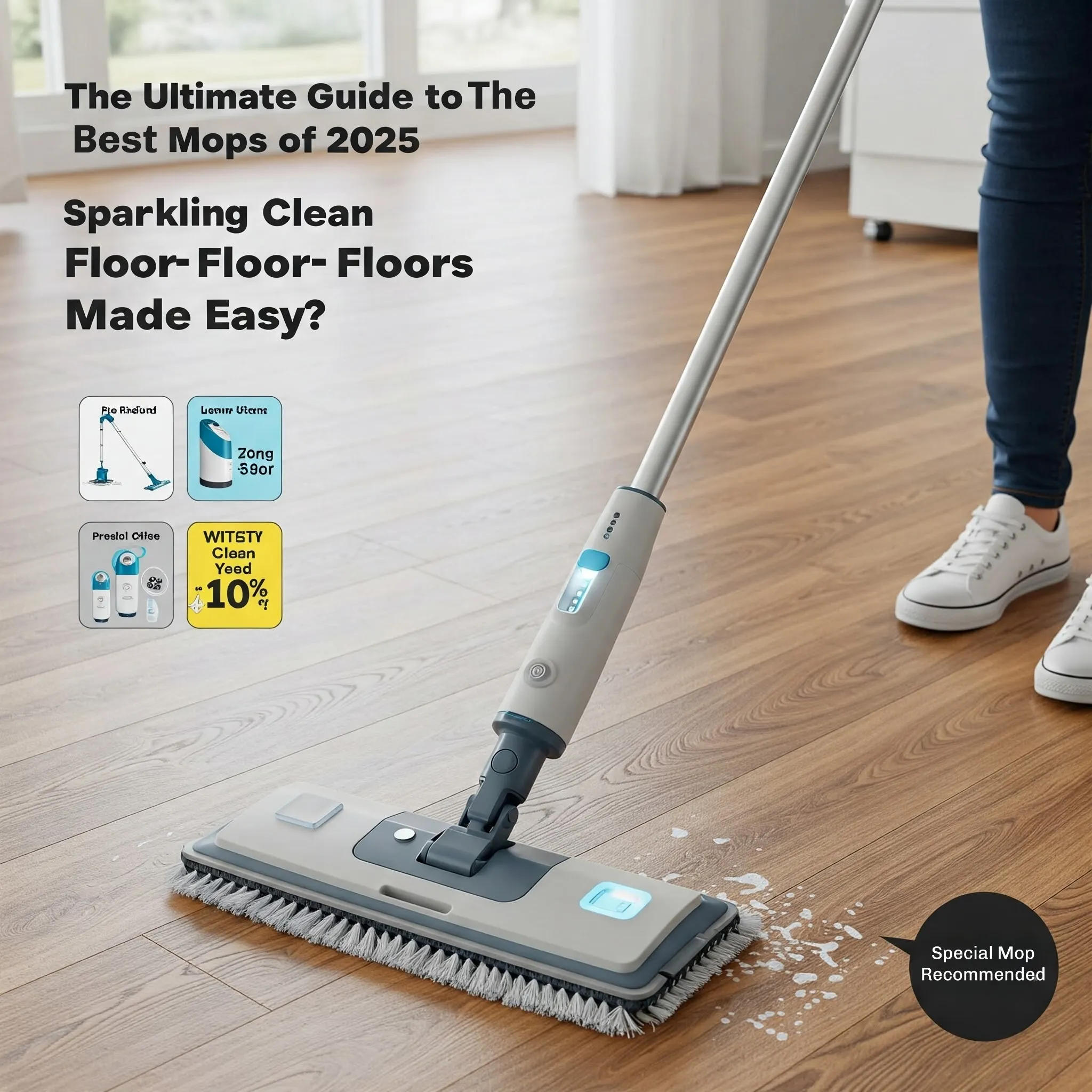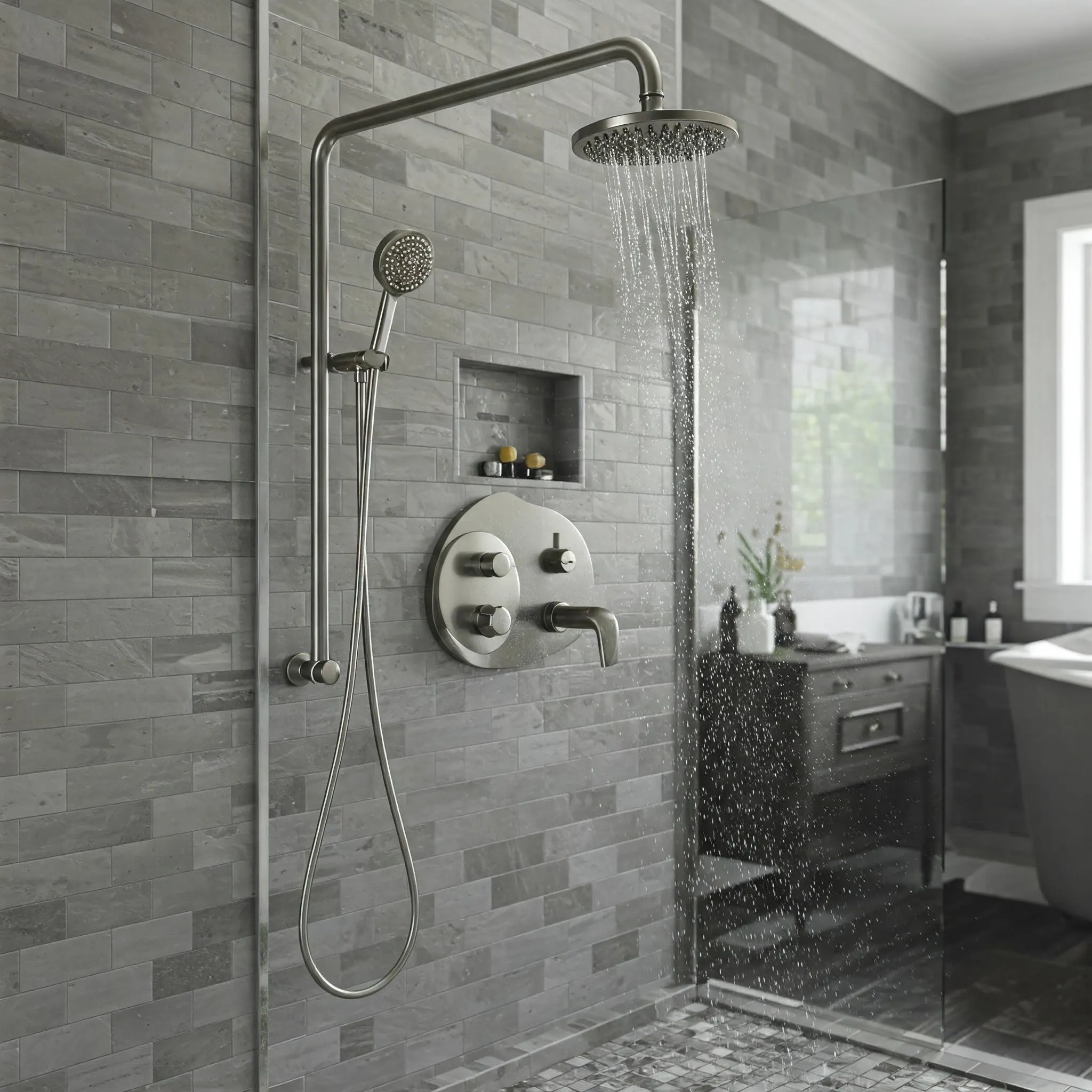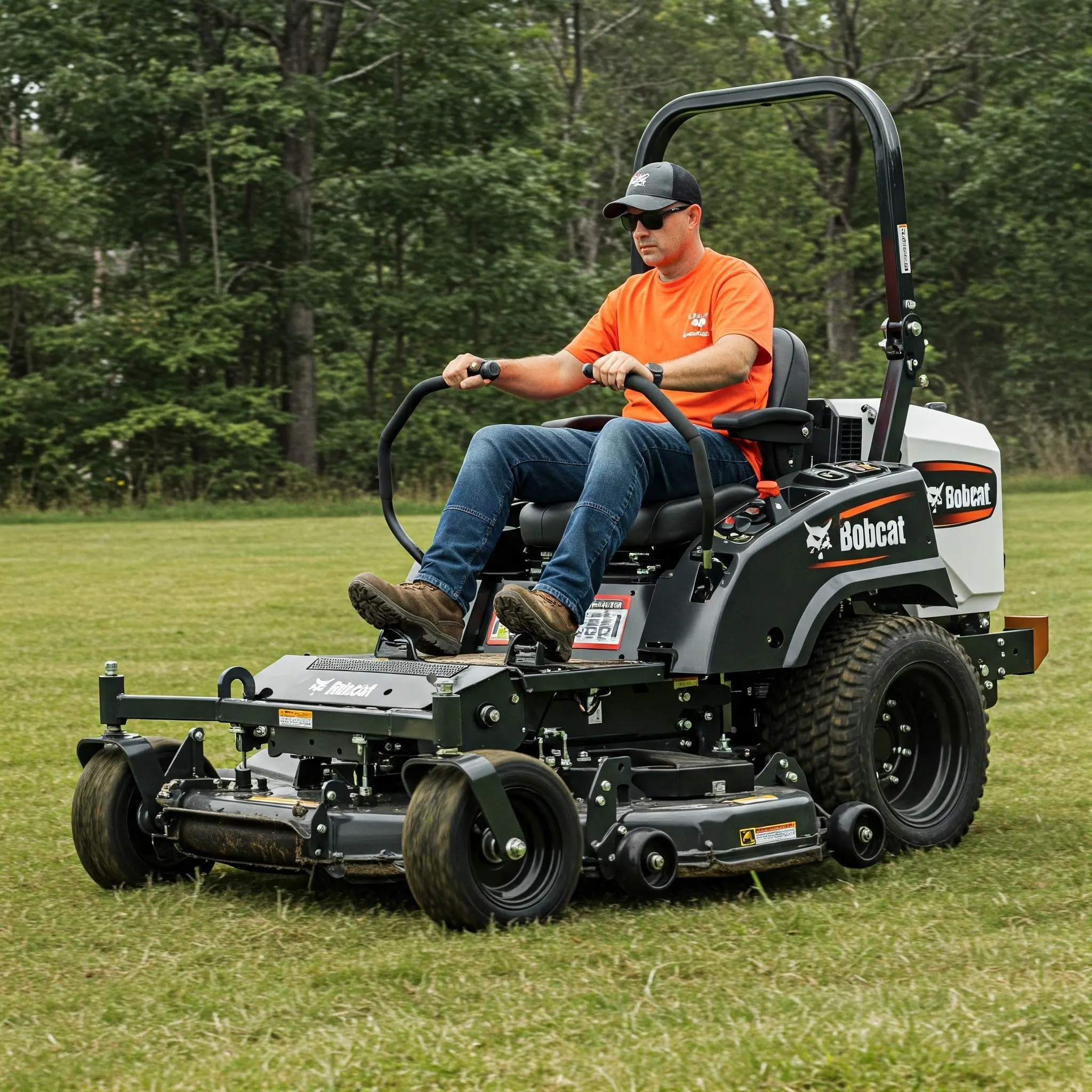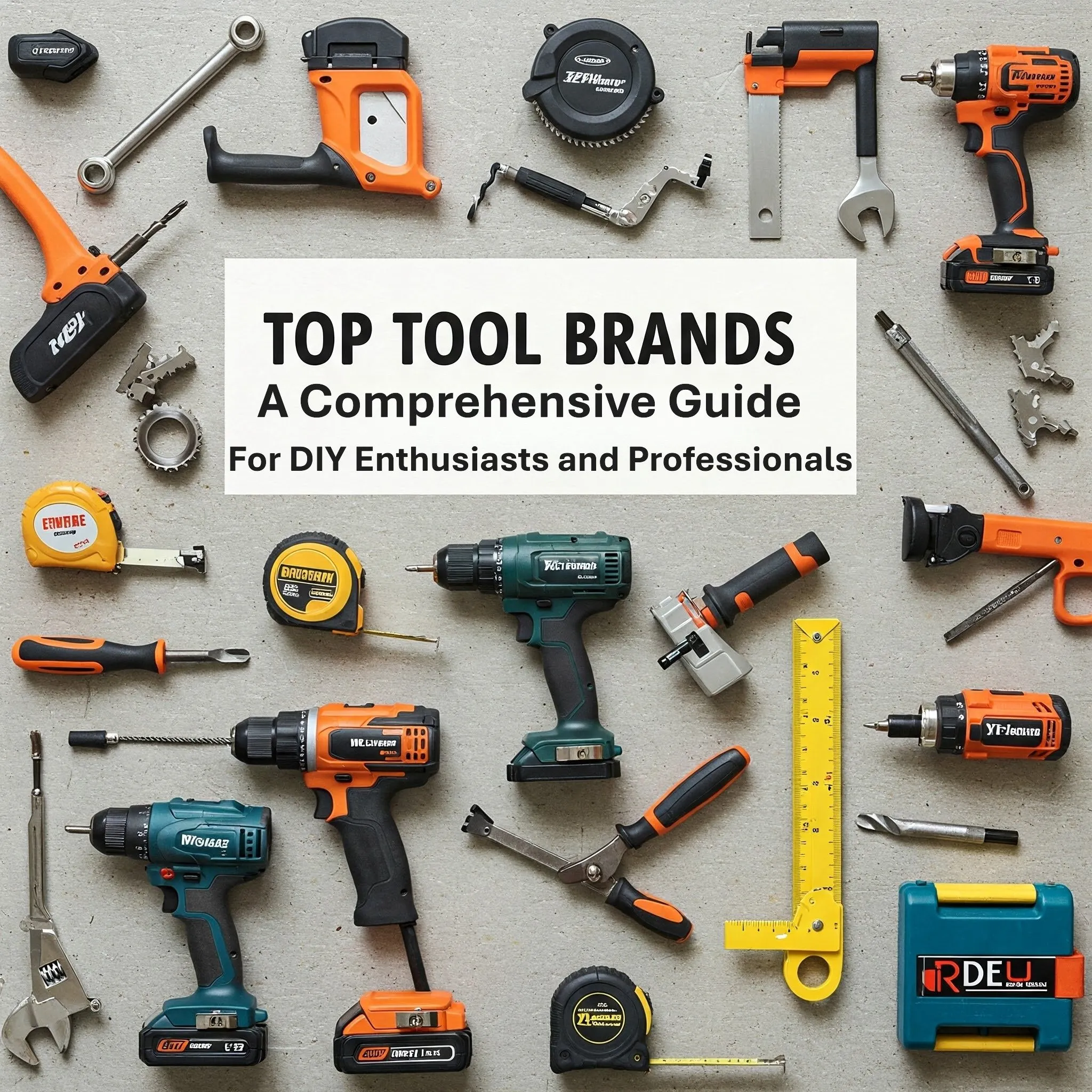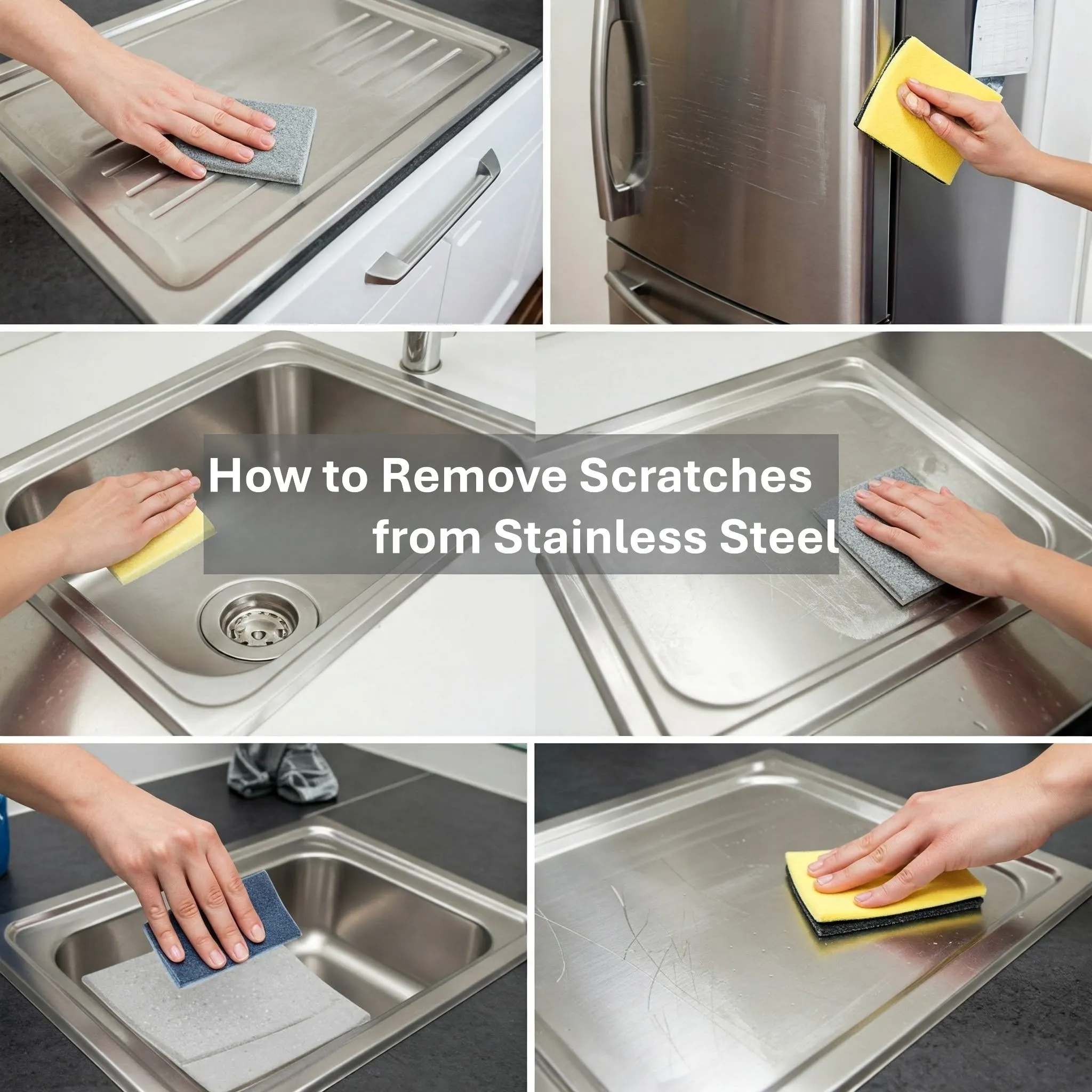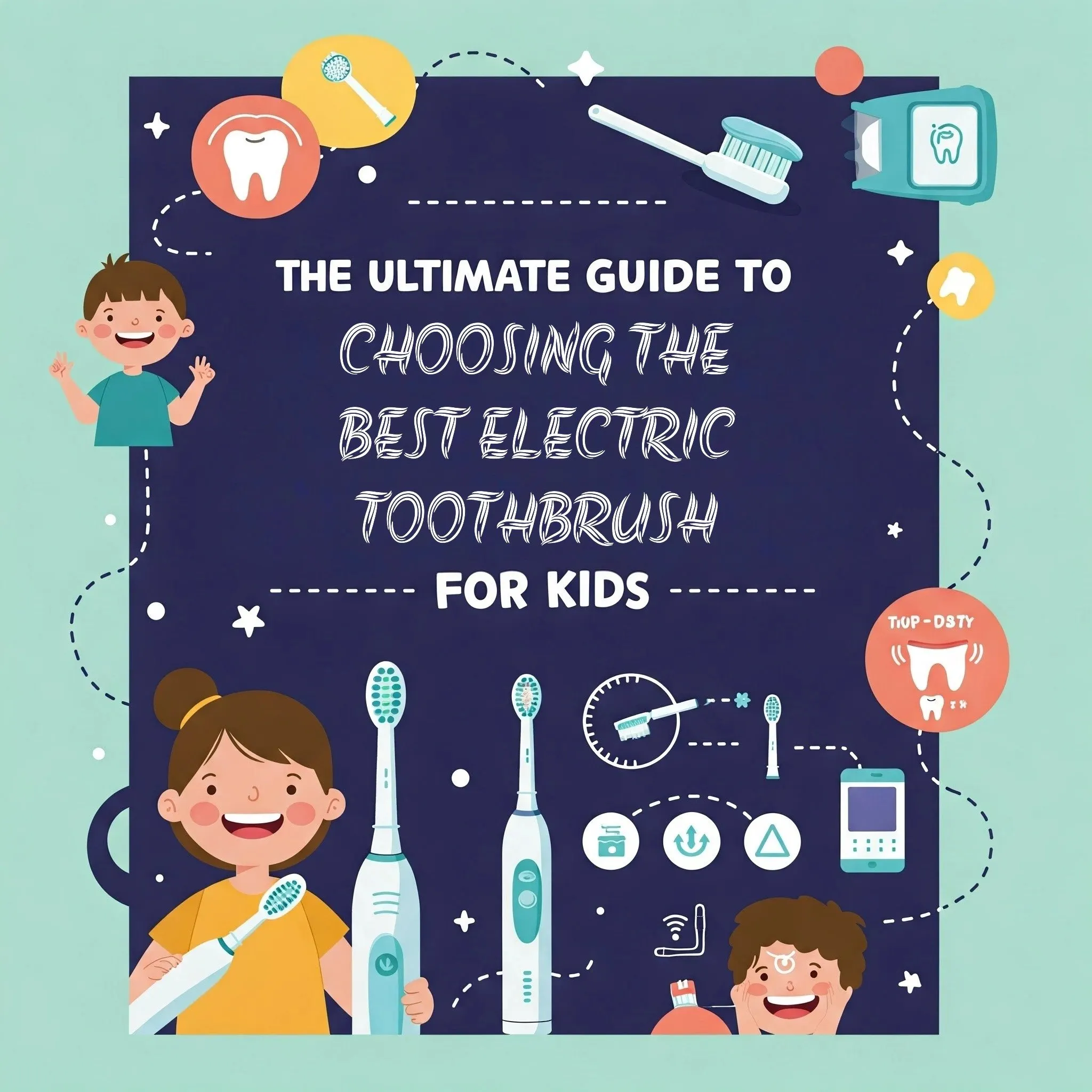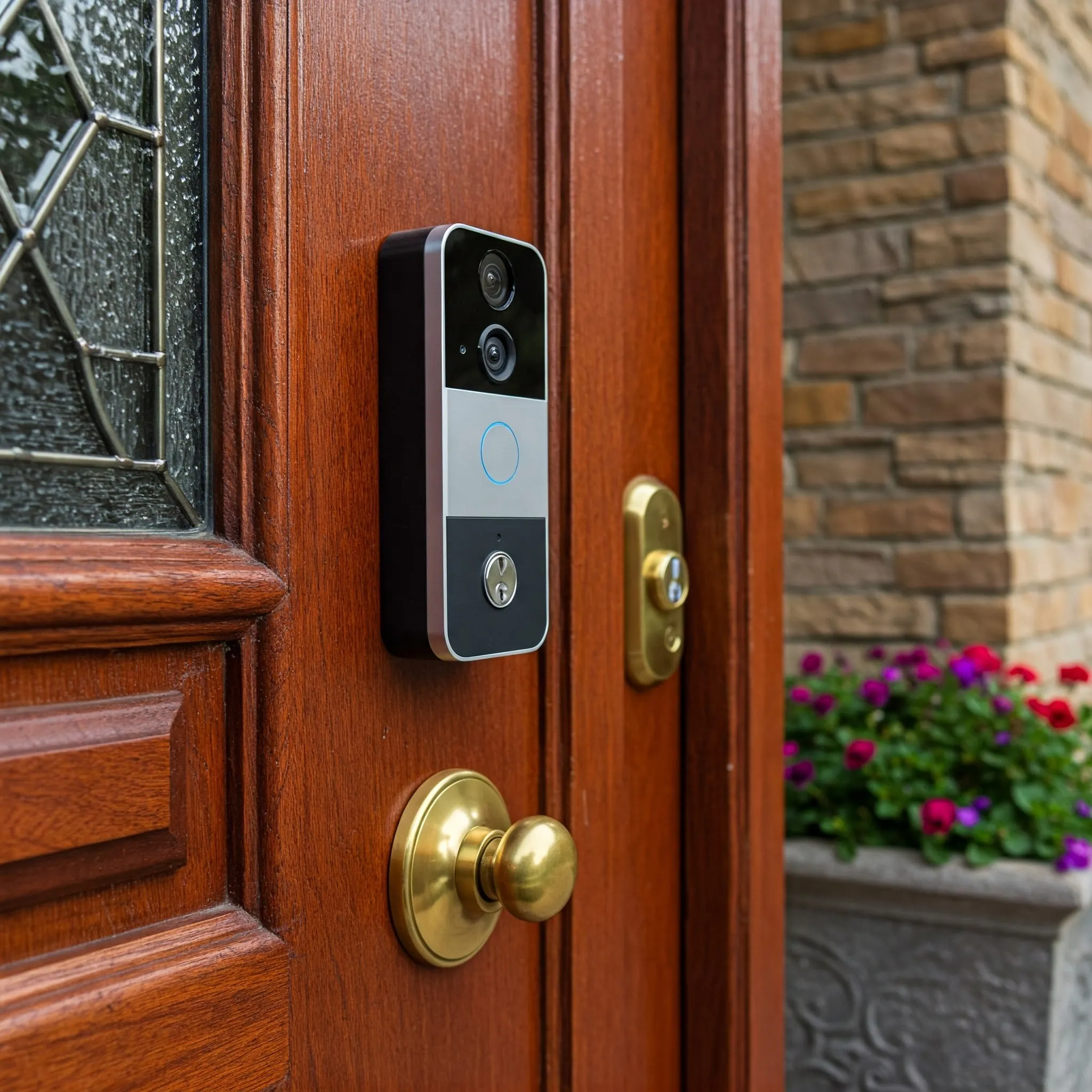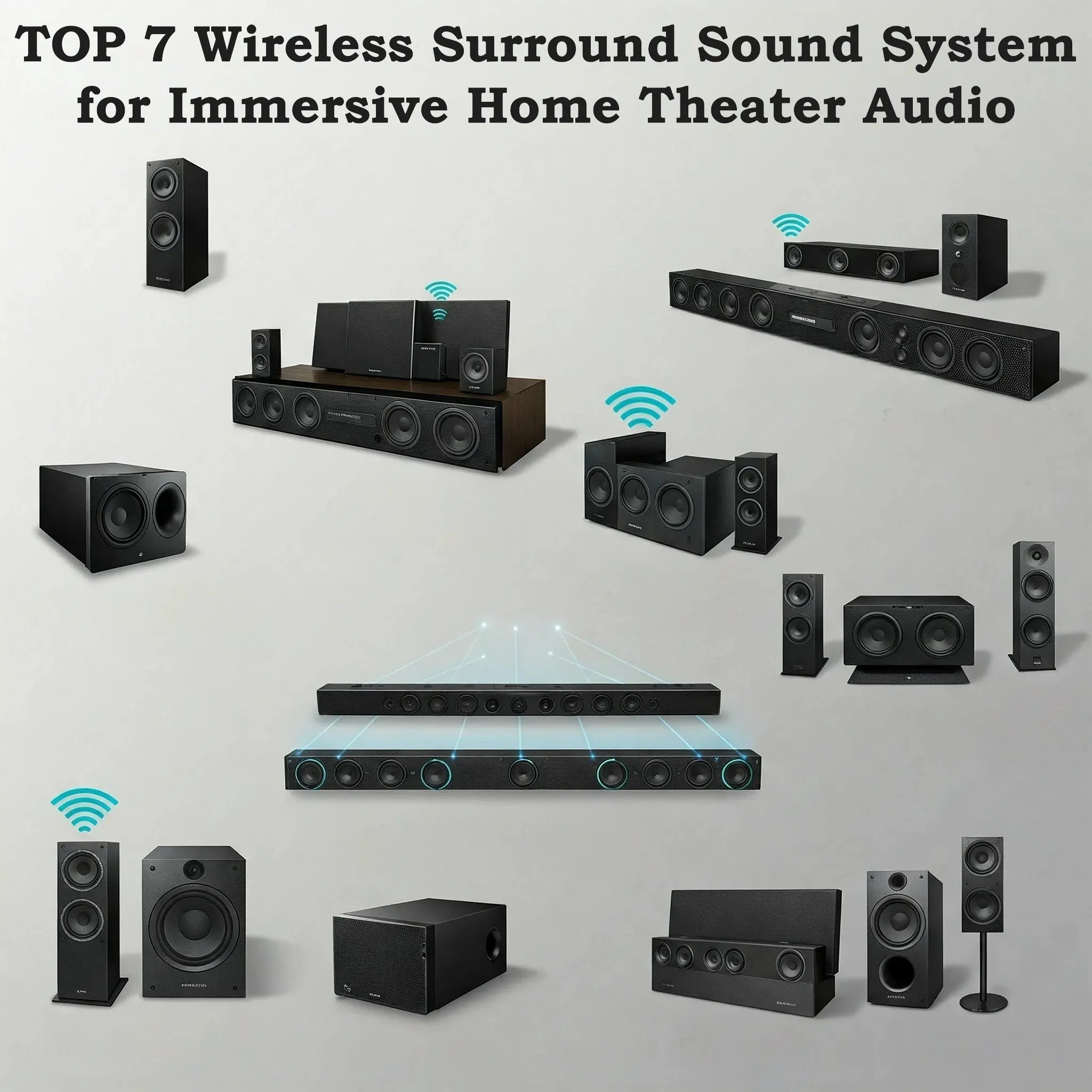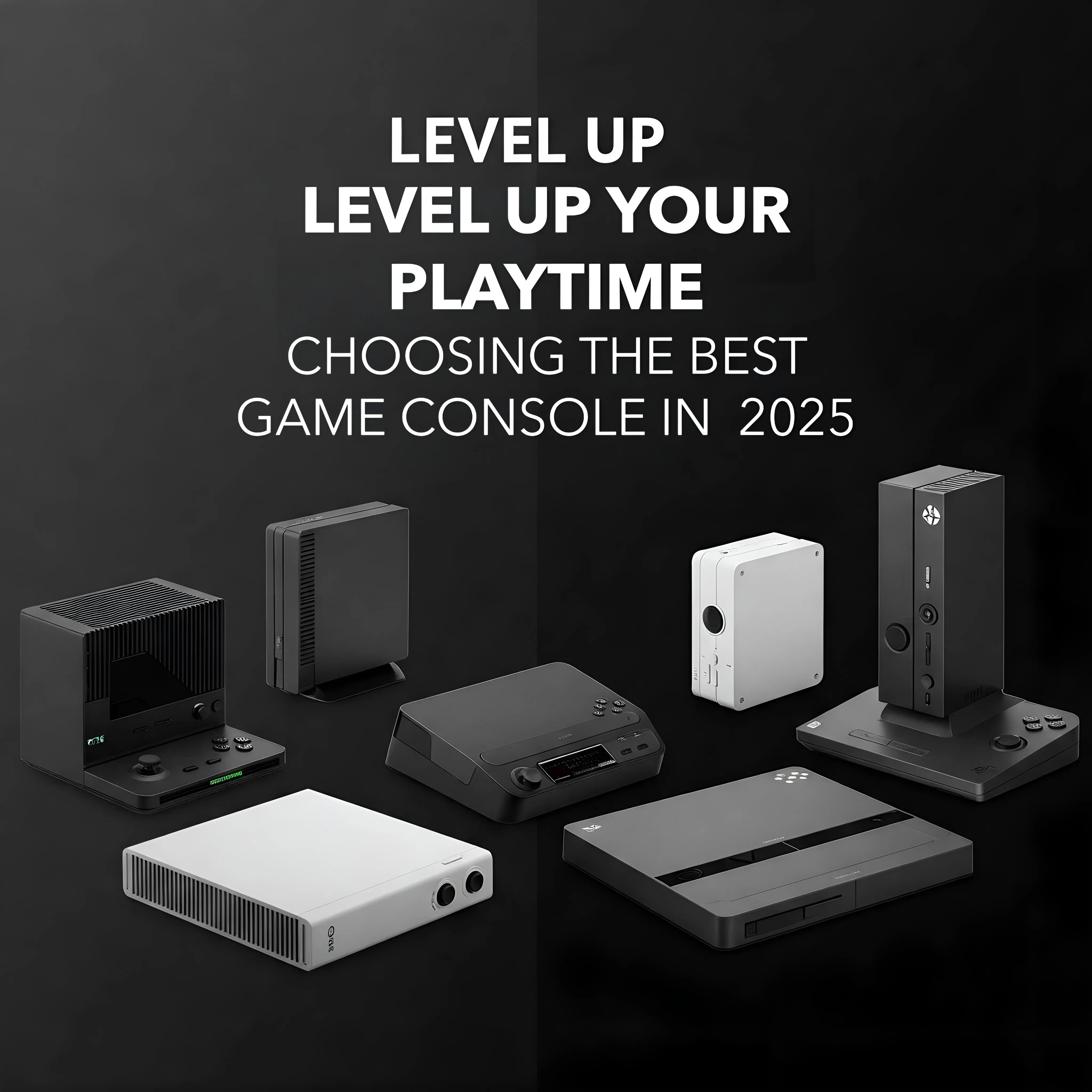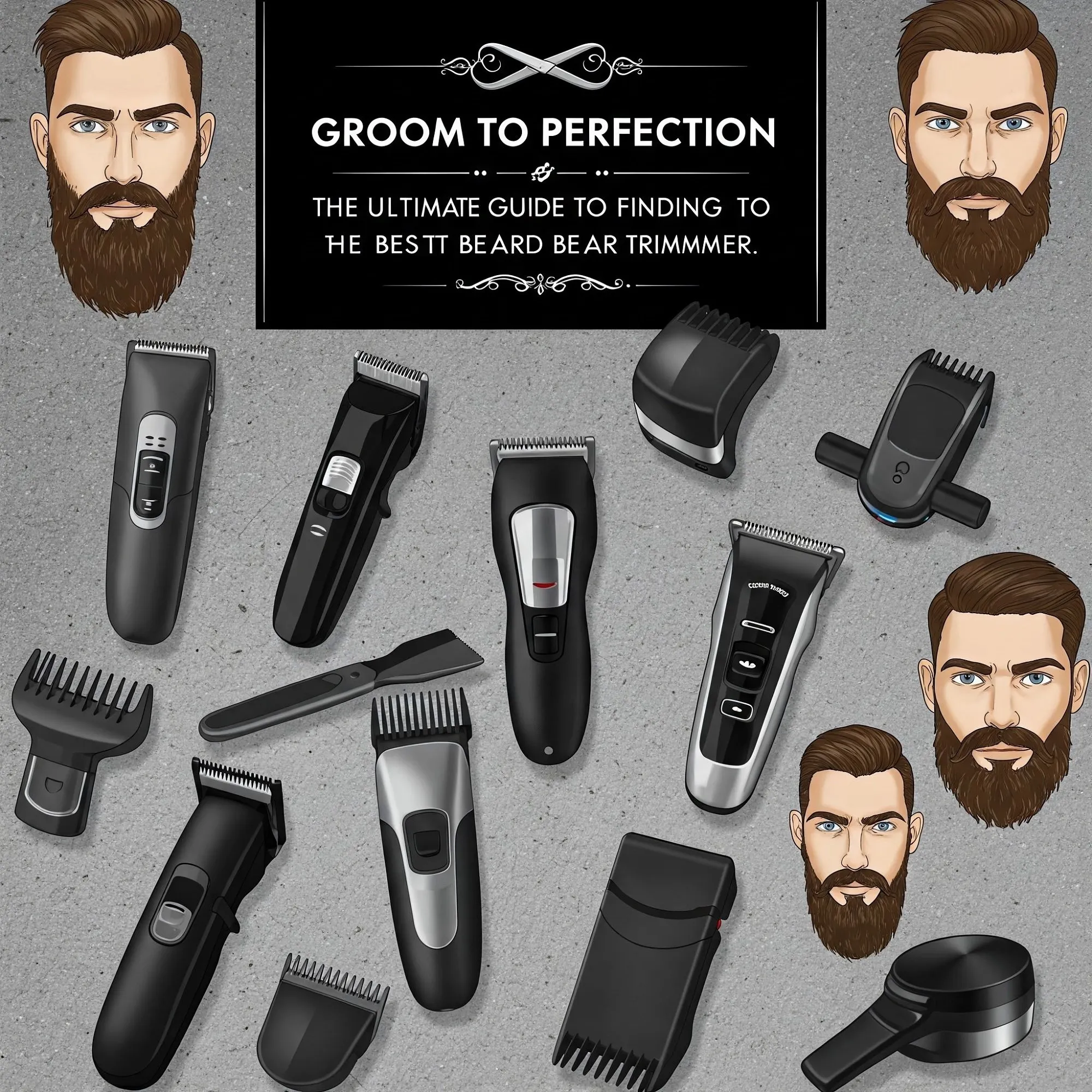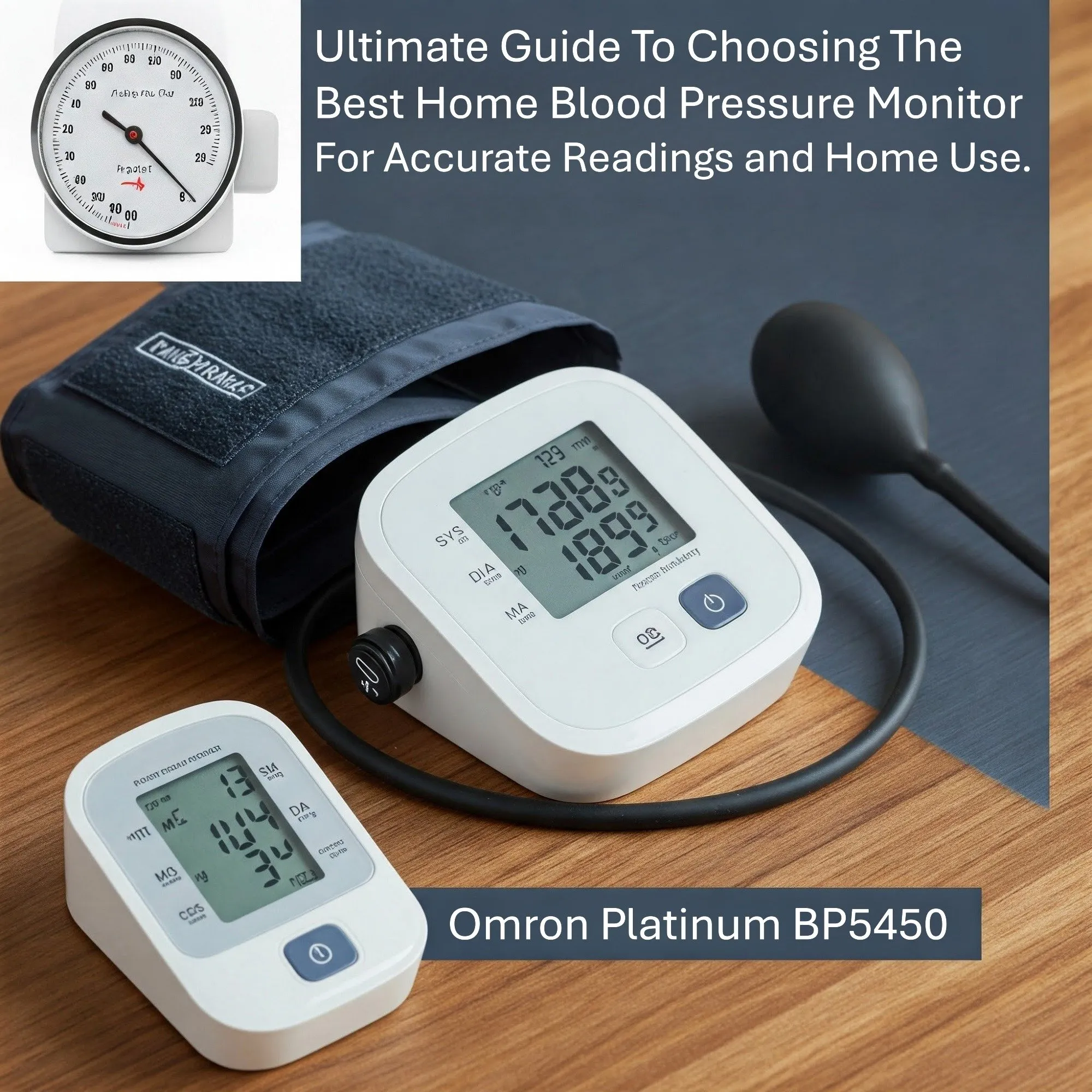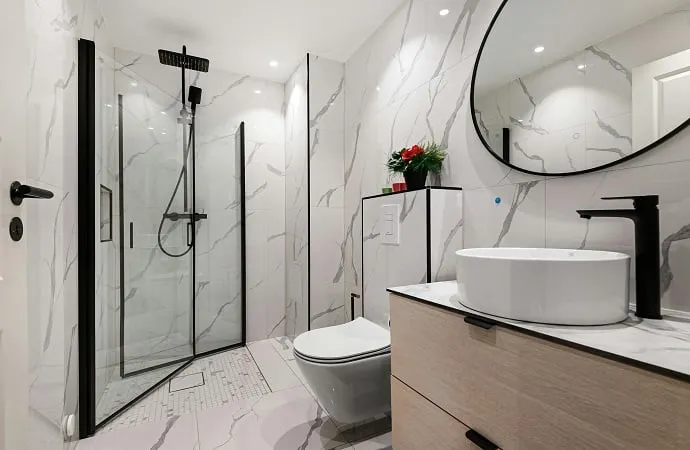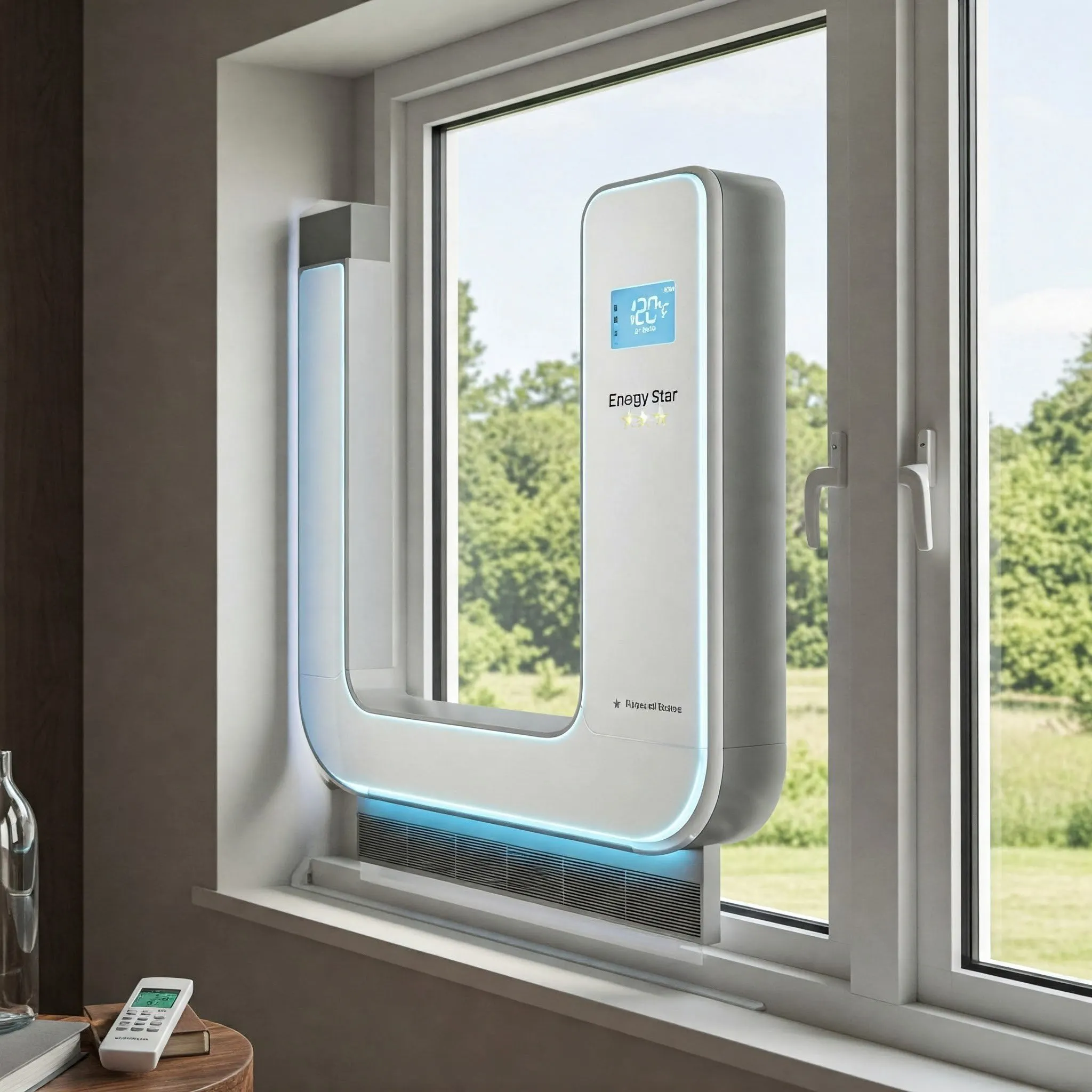Finding the Best Power Electric Toothbrush for a Sparkling Smile

Showcasing healthy, white teeth
"Please be advised that we may receive compensation from the products featured on this page, and we participate in affiliate programs. Learn More ›"
In today's fast-paced world, prioritizing oral hygiene is more crucial than ever. While manual toothbrushes have been a staple for centuries, electric toothbrushes have emerged as a game-changer in achieving a truly deep and effective clean. If you're considering upgrading your oral care routine, transitioning from a manual to an electric toothbrush could be a worthwhile investment.
Electric toothbrushes offer several advantages, primarily doing much of the "brushing" work for you. This is particularly beneficial for those who may struggle with consistent brushing technique or duration. The built-in timers and powerful motors in electric models ensure you brush for the dentist-recommended two minutes, reaching every corner of your mouth with optimized plaque removal.
After dedicating over numerous hours to in-depth research, consulting dental experts, evaluating almost every model on the market, and personally testing numerous different toothbrushes in countless brushing sessions, we’ve pinpointed the electric toothbrushes that stand out from the rest. Whether you're seeking enhanced cleaning power, guided brushing, or simply a more effective way to maintain a healthy smile, this guide will illuminate the path to finding the best electric toothbrush for your needs.
====================================================================
Everything We Recommend: Our Top Electric Toothbrush Choices
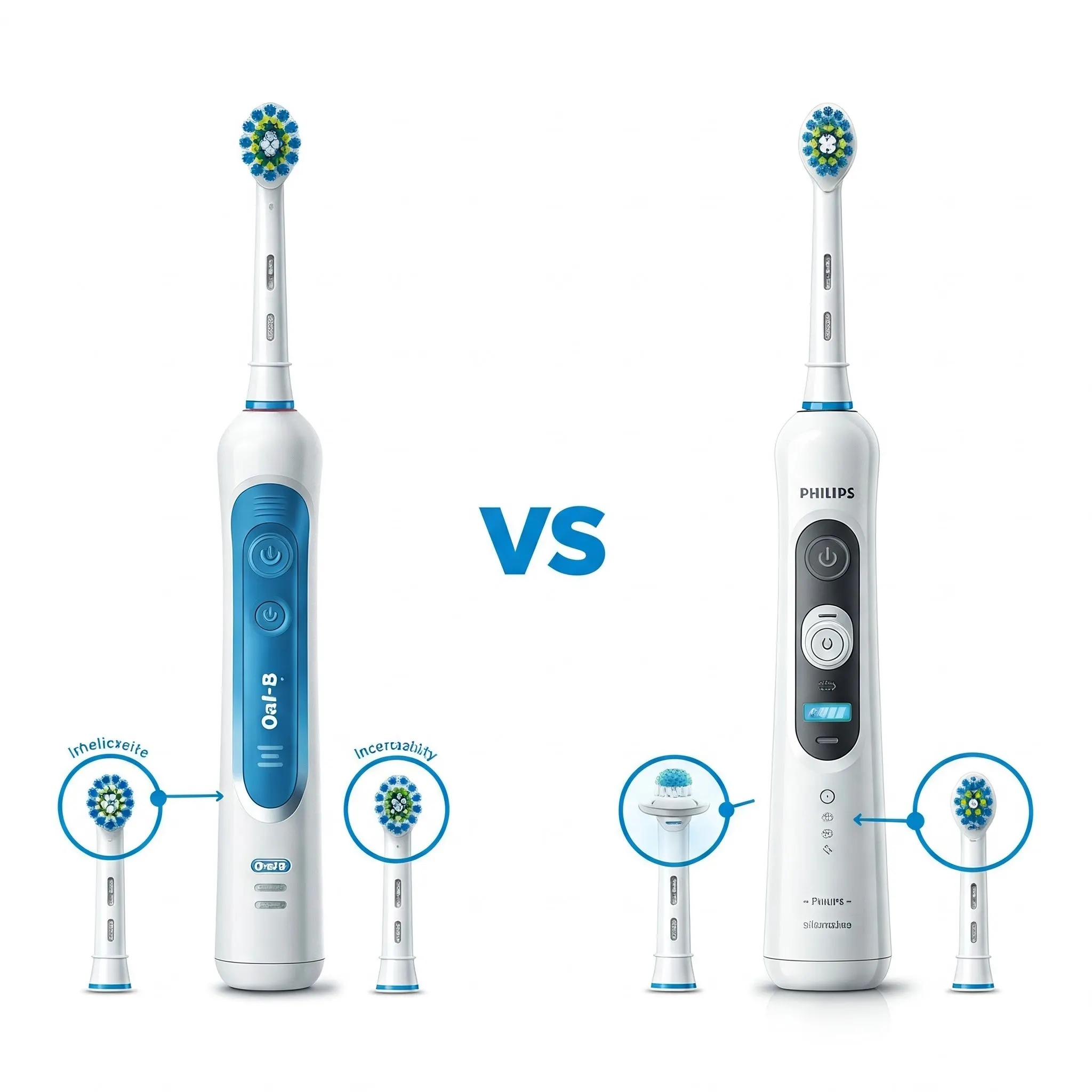
Oral-B Pro 1000 and Philips Sonicare 4100
For those looking to upgrade to an electric toothbrush without getting lost in a sea of overly complex features, we have two clear recommendations that consistently deliver exceptional cleaning power and value:
- Top Pick: Oral-B Pro 1000. This oscillating marvel provides all the essential features experts recommend – a two-minute timer, a pressure sensor, and compatibility with a vast range of affordable replacement brush heads. It's the workhorse of electric toothbrushes, focusing on core functionality without unnecessary frills.
- Runner-Up: Philips Sonicare 4100. If you prioritize a quieter brushing experience without sacrificing effectiveness, the Philips Sonicare 4100 is a superb alternative. This vibrating brush matches our top pick in key features but operates more quietly, though its replacement brush heads are pricier.
These two models consistently outperformed others in our rigorous testing, offering the best balance of cleaning efficacy, user-friendliness, and value. Let's delve deeper into what makes them our top choices.
====================================================================
Our Top Pick: Oral-B Pro 1000 - The Best Overall Electric Toothbrush

Oral-B Pro 1000 electric toothbrush
For nearly a decade, the Oral-B Pro 1000 has remained our undisputed top pick, and for good reason. In a market saturated with electric toothbrushes boasting superfluous features, the Pro 1000 shines by delivering superior value and focusing on what truly matters: effective cleaning. This oscillating brush is a powerhouse of oral hygiene, equipped with essential features that dental professionals recommend, all at an accessible price point.
Key Features that Set it Apart:
- Powerful Oscillating Motor: The Oral-B Pro 1000 is equipped with a robust motor that delivers up to 48,800 movements per minute, effectively removing plaque and promoting gum health. This powerful motor does the heavy lifting, allowing you to gently guide the brush across your teeth.
- Built-in Two-Minute Timer with Quadrant Pacing: Ensuring you brush for the dentist-recommended two minutes, the Pro 1000 features a timer that buzzes every 30 seconds. This quadrant pacing system guides you to spend equal time cleaning each section of your mouth, promoting thorough and even cleaning.
- Audible Pressure Sensor: Brushing too hard can damage your gums and enamel. The Pro 1000's audible pressure sensor alerts you when you're applying too much force, helping you protect your delicate gum line.
- Long-Lasting Battery: In our tests, the Pro 1000's battery reliably lasted for at least a week of twice-daily brushing on a single charge, ensuring you don't have to constantly worry about recharging.
- Extensive and Affordable Replacement Brush Heads: One of the Pro 1000's biggest strengths is its compatibility with Oral-B's extensive line of replacement brush heads. With eight different types to choose from, you can find the perfect brush head for your individual needs. Importantly, these replacement heads are more affordable than many competitors, making long-term ownership cost-effective.
Buying Options:
- [$50 from Amazon]
- [$50 from Walmart]
Minor Drawbacks, Not Dealbreakers:
- Louder Operation: The Pro 1000 is audibly louder than some competitors, particularly Philips Sonicare models. However, most users quickly adapt to the sound.
- Manual Shut-Off: Unlike some models, the Pro 1000 requires manual shut-off even after the two-minute timer completes.
Despite these minor points, the Oral-B Pro 1000's superior cleaning performance, essential features, durability, and affordable replacement heads solidify its position as our top pick for the best electric toothbrush.
====================================================================
Runner-up: Philips Sonicare 4100 - A Quieter, Premium Option
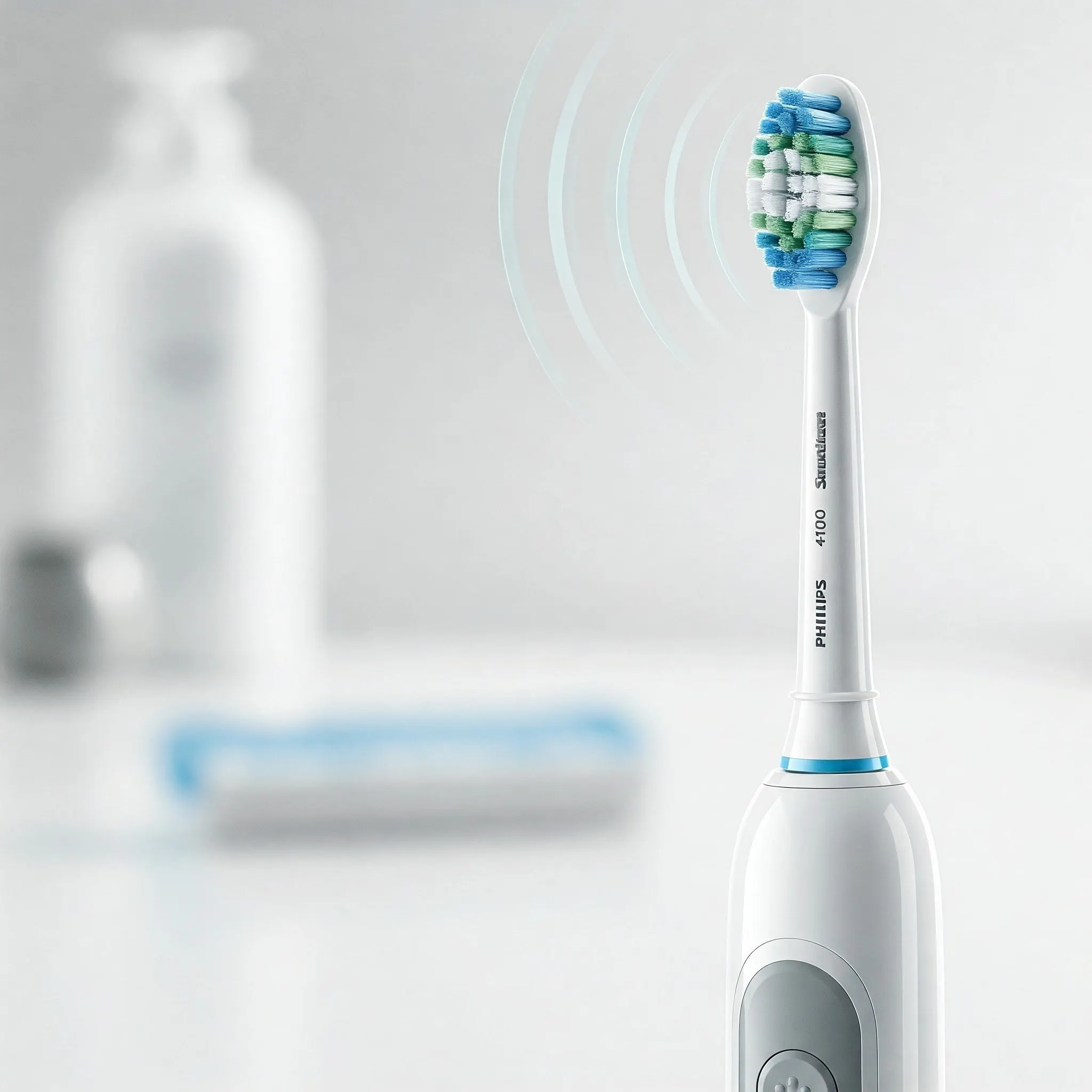
Philips Sonicare 4100 electric toothbrush
If a quieter brushing experience is a high priority for you, the Philips Sonicare 4100 is an excellent runner-up that delivers comparable cleaning power with less noise. This vibrating toothbrush shares the crucial features of our top pick but operates more discreetly, making it a great choice for noise-sensitive individuals.
Advantages of the Philips Sonicare 4100:
- Quieter Sonic Vibrations: The Sonicare 4100 utilizes sonic vibrations that are noticeably quieter than the oscillating rotations of the Oral-B Pro 1000. In our sound tests, it registered around 30 decibels, making for a more peaceful brushing routine.
- Essential Features Mirror Our Top Pick: The 4100 matches the Pro 1000 in essential features, including a two-minute timer with quadrant pacing, an audible pressure sensor, and a long-lasting battery.
- Automatic Power-Down: A convenient feature not found in our top pick, the Sonicare 4100 automatically powers off after the two-minute brushing cycle is complete.
- Variety of Brush Head Options: The 4100 is compatible with Philips Sonicare's extensive range of brush heads, offering even more options (ten in total) than Oral-B.
- Excellent Battery Life: The Sonicare 4100 boasts impressive battery life, lasting an average of 16 days in our testing, exceeding Philips's two-week claim and surpassing the Oral-B Pro 1000.
Buying Options:
- [$40 from Amazon]
- [$46 from Walmart]
Considerations:
- More Expensive Replacement Brush Heads: The primary drawback of the Sonicare 4100 is the higher cost of its replacement brush heads. They can be more than double the price of Oral-B's, increasing the long-term cost of ownership.
- Vibrations Can Feel More Intense: Some users might find the vibrations of the Sonicare 4100 more noticeable or even slightly uncomfortable, especially at its higher intensity setting.
Despite the higher refill costs, the Philips Sonicare 4100 remains a compelling choice for those who value a quieter electric toothbrush that delivers excellent cleaning performance and a premium feel. Its quieter operation and automatic shut-off are notable advantages that may sway users seeking a more refined brushing experience.
====================================================================
What to Look for in an Electric Toothbrush: Key Features for a Healthy Smile
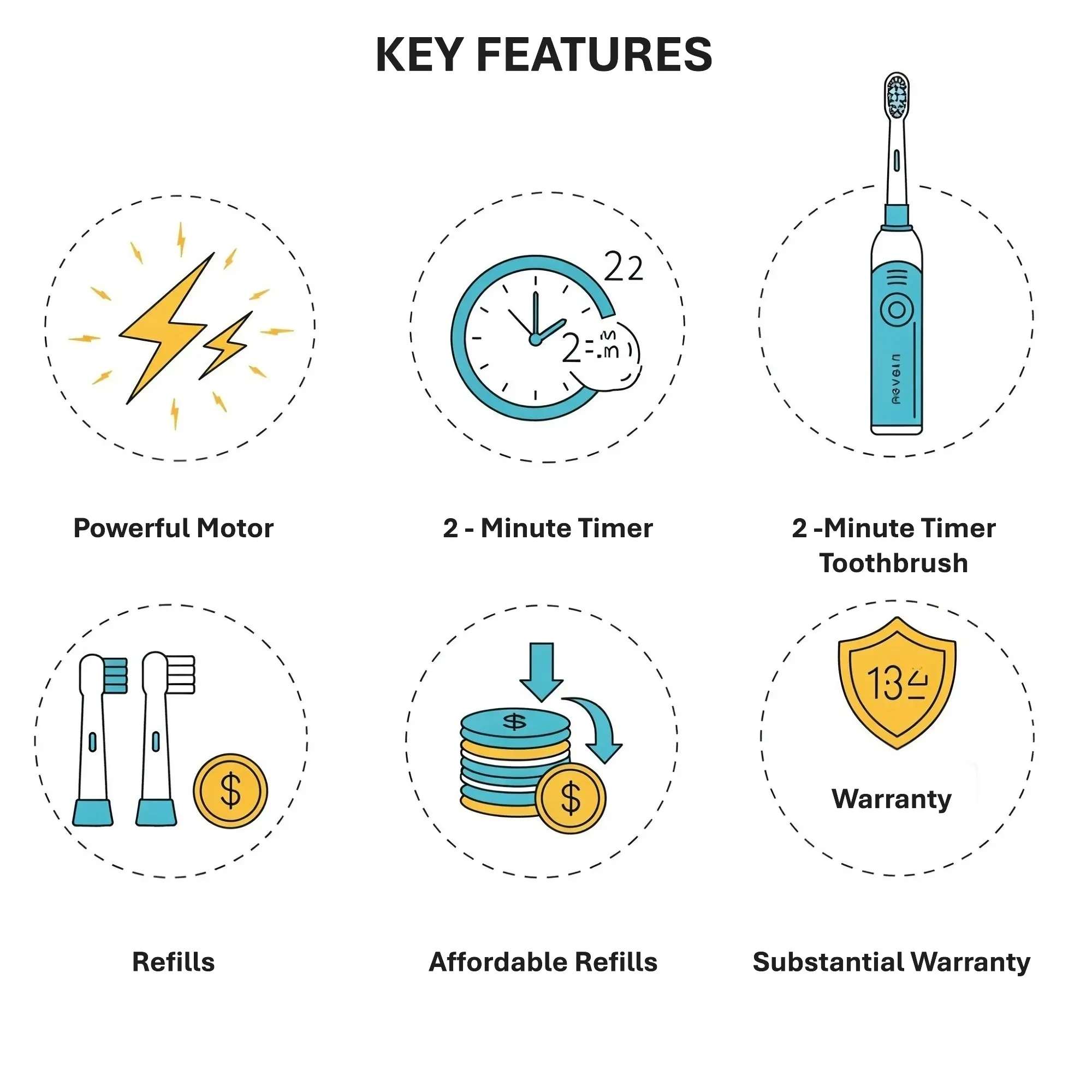
Key features of an electric toothbrush
Choosing the right electric toothbrush can feel overwhelming with so many options available. To simplify your decision, focus on these essential features that contribute to effective cleaning and long-term satisfaction:
- Powerful Motor: A quality electric toothbrush should have a motor strong enough to effectively remove plaque and debris. Whether oscillating or vibrating, the brush head should do the majority of the "brushing" for you.
- Two-Minute Timer: A built-in timer is crucial to ensure you brush for the dentist-recommended two minutes. Quadrant pacing, which signals every 30 seconds to switch brushing areas, is an added bonus for even cleaning.
- Affordable and Widely Available Refills: Consider the long-term cost of ownership by checking the price and availability of replacement brush heads. Opt for brands with a wide range of affordable and easily accessible refills.
- Substantial Warranty: A solid warranty provides peace of mind, indicating the manufacturer's confidence in the product's durability and offering support should any issues arise.
Both our top picks, the Oral-B Pro 1000 and Philips Sonicare 4100, excel in these critical areas. They both offer powerful motors, two-minute timers with quadrant pacing, and readily available replacement brush heads. While Philips Sonicare heads are pricier, Oral-B's affordable refills give the Pro 1000 an edge in long-term cost-effectiveness. Both brands offer reputable warranties.
Approximate Cost of Ownership: Comparing Long-Term Expenses
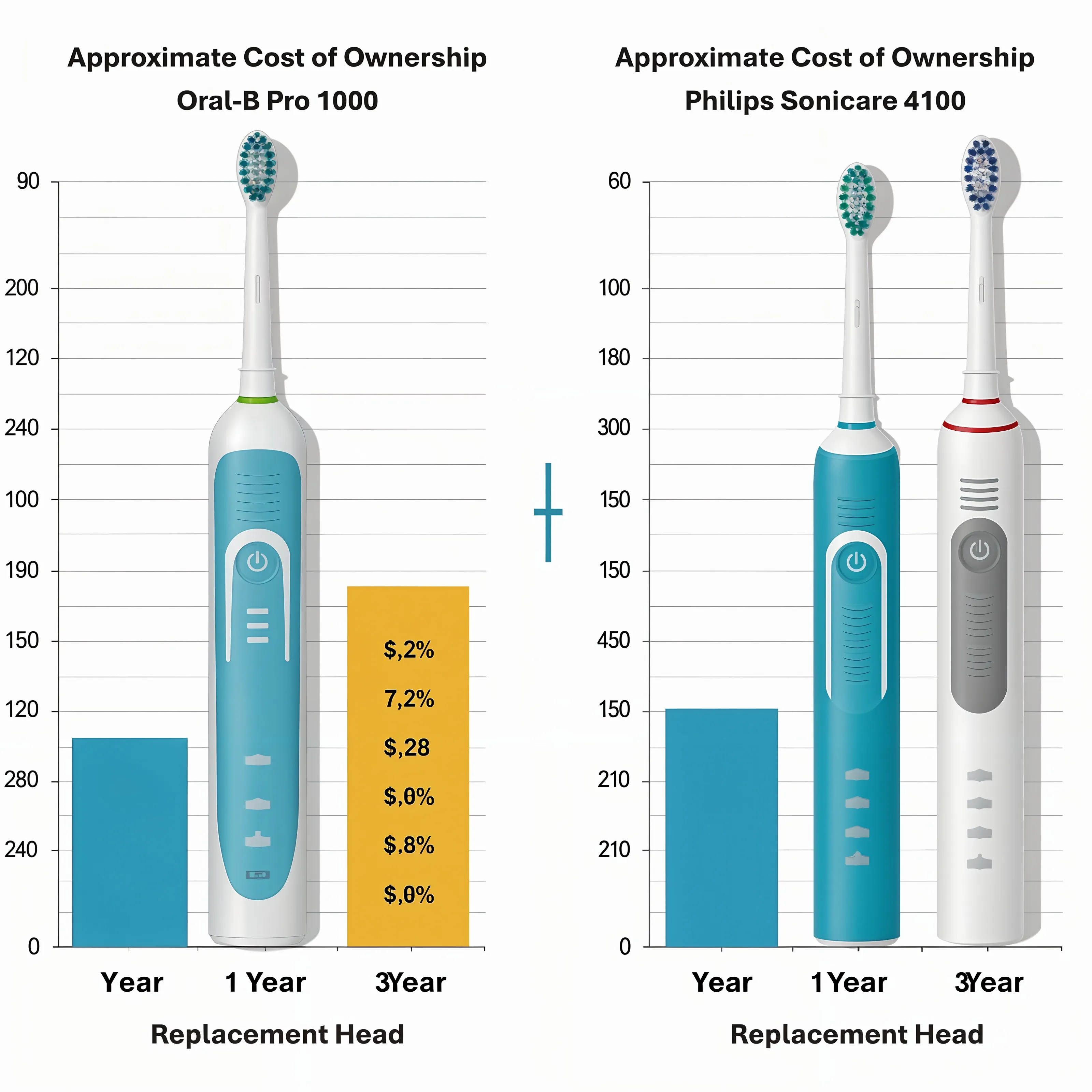
Comparing Long-Term Expenses
When choosing an electric toothbrush, it's essential to consider not just the initial purchase price but also the ongoing cost of replacement brush heads. Here's an approximate breakdown of the cost of ownership for our top picks over one and three years, assuming quarterly replacement of brush heads:
Oral-B Pro 1000:
- One Year: $50 (brush handle) + ($16/year for refills - assuming $4 per head x 4 refills) = $66
- Three Years: $50 (brush handle - assuming handle lasts) + ($48/3 years for refills - assuming $16/year) = $98
Philips Sonicare 4100:
- One Year: $50 (brush handle) + ($40/year for refills - assuming $10 per head x 4 refills) = $90
- Three Years: $50 (brush handle - assuming handle lasts) + ($120/3 years for refills - assuming $40/year) = $170
As you can see, while the initial cost might be similar, the Philips Sonicare 4100 becomes significantly more expensive over time due to the higher price of its replacement brush heads. This cost difference is a crucial factor to consider, especially for budget-conscious consumers.
====================================================================
Why You Should Trust Us: Rigorous Testing and Expert Insights
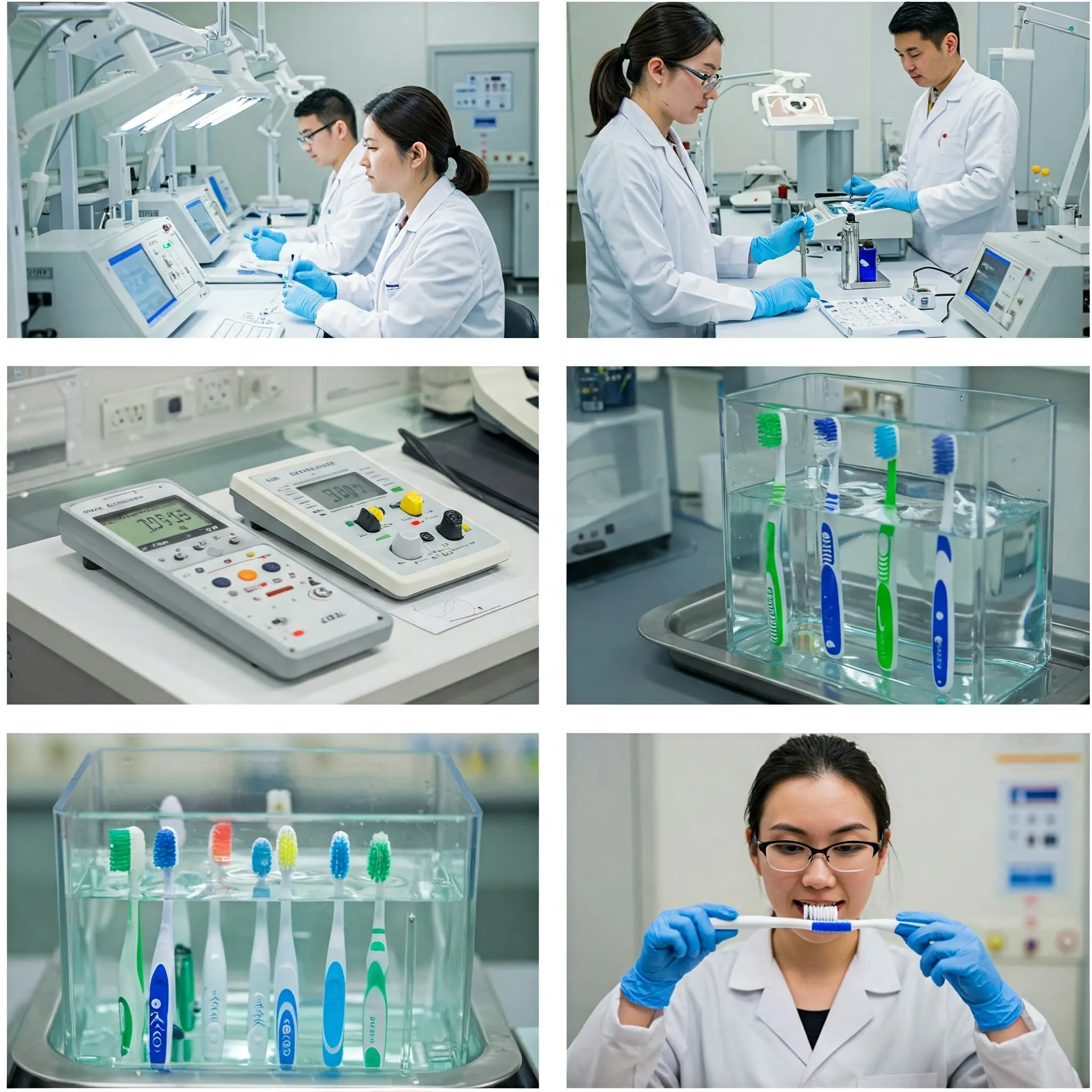
Testing process
Our recommendations aren't based on mere opinions; they're rooted in rigorous testing and extensive research. To identify the best electric toothbrushes, we've undertaken a comprehensive evaluation process, including:
- Consulting Oral Health Experts: We sought guidance from dentists, dental hygienists, and faculty at leading dental schools and research universities. We also consulted consumer advisors from the American Dental Association (ADA), which signifies products meeting stringent safety and efficacy standards through their Seal of Acceptance program.
- Decades of Research and Testing: Over the past decade, we've invested over 120 hours researching and evaluating electric toothbrushes. This includes reviewing scientific studies, reading consumer reports, and testing over five dozen powered toothbrushes.
- Real-World Testing: Our team, including a senior health and grooming writer with years of experience testing oral care products, has personally tested over 100 electric toothbrushes over the past five years. This hands-on testing involved using each brush twice daily for extended periods, timing battery life, assessing noise levels, evaluating durability through drop and submersion tests, and replacing brush heads regularly.
This thorough approach ensures our recommendations are based on solid evidence, expert consensus, and real-world user experience, providing you with trustworthy guidance in choosing the best electric toothbrush for your needs.
====================================================================
Who This Is For: Is an Electric Toothbrush Right for You?

Is an Electric Toothbrush Right for You
According to the American Dental Association (ADA), both manual and electric toothbrushes can effectively clean your teeth when used correctly with fluoride toothpaste. The key to oral hygiene is consistent and proper brushing technique, regardless of the tool.
====================================================================
Who Might Benefit from an Electric Toothbrush?
- Individuals Seeking Enhanced Plaque Removal: Studies have consistently shown that electric toothbrushes generally remove more plaque and reduce gingivitis compared to manual toothbrushes. The powered motion and built-in timers encourage longer and more effective brushing.
- Those Who Want to Improve Brushing Habits: Electric toothbrushes can assist individuals in brushing for the full two minutes recommended by dentists. The quadrant pacing feature ensures even cleaning across the entire mouth.
- People Who Prefer Less Physical Effort: Electric toothbrushes do most of the "brushing" work, requiring less manual effort, which can be beneficial for individuals with dexterity issues or those who simply prefer a more effortless brushing experience.
- Individuals Seeking Guidance and Feedback: Smart toothbrushes, discussed later in this article, offer advanced features like brushing habit tracking and real-time feedback, which can be helpful for those who desire more guidance.
Who Might Not Need to Upgrade?
- Satisfied Manual Brush Users: If you are already diligent about your oral hygiene with a manual toothbrush and maintain good brushing habits, there's no compelling need to switch to an electric toothbrush.
- Budget-Conscious Individuals: Electric toothbrushes and their replacement heads are generally more expensive than manual options. If cost is a primary concern, a manual toothbrush used effectively remains a viable choice.
Ultimately, the decision to switch to an electric toothbrush is a personal one. While they offer potential benefits in terms of plaque removal and brushing technique, a manual toothbrush can be equally effective when used correctly.
====================================================================
How We Picked and Tested: Our Comprehensive Evaluation Process
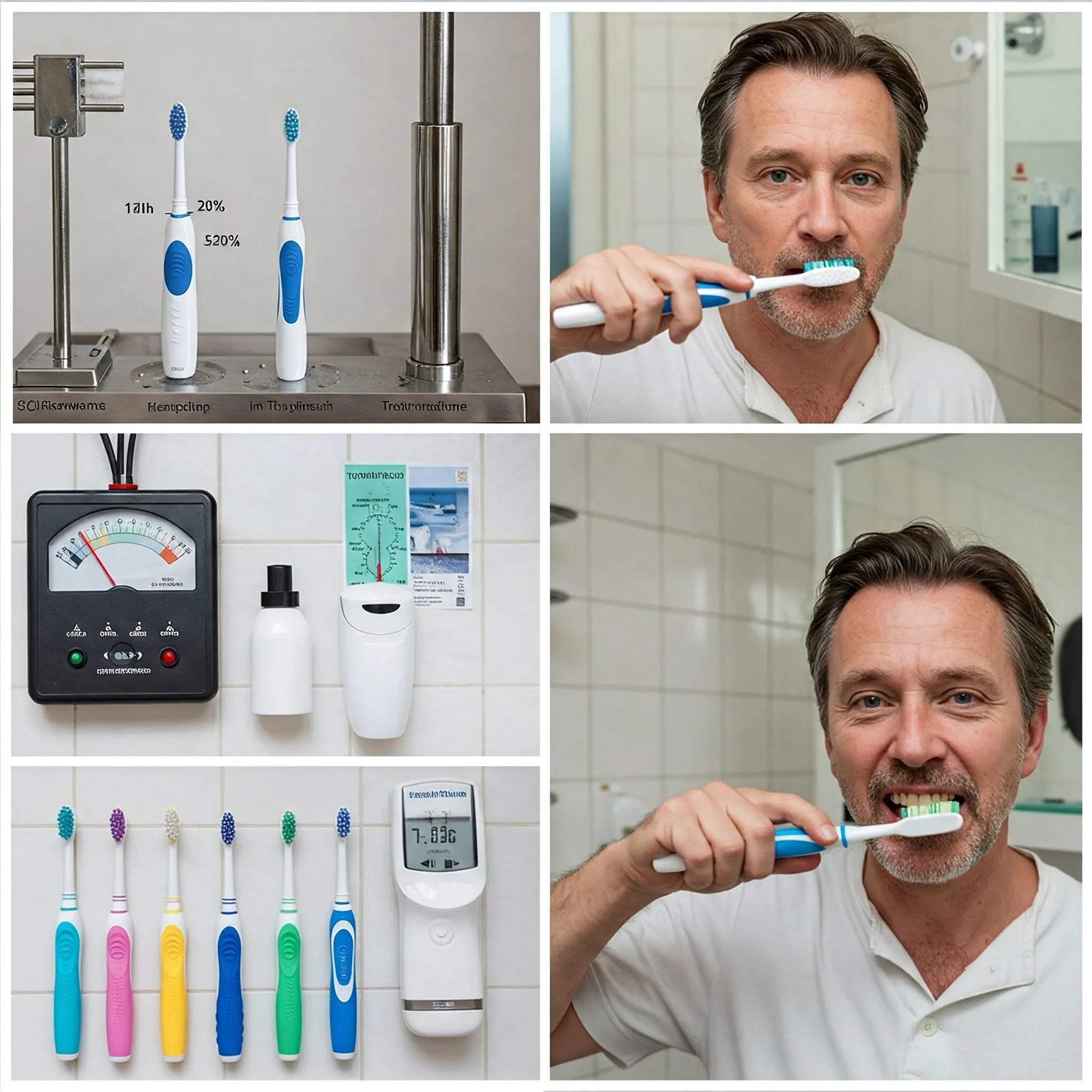
Toothbrush testing process
Our selection process for the best electric toothbrushes was rigorous and multi-faceted, involving both expert consultation and extensive hands-on testing. Here’s a detailed look at our methodology:
- Feature Prioritization: We prioritized essential features based on expert recommendations, focusing on:
- Automated Two-Minute Timer: Essential for ensuring adequate brushing time.
- Affordable, Widely Available Replacement Heads: Crucial for long-term cost-effectiveness and convenience.
We also considered "nice-to-have" features like:
- Quadrant Pacing: For even cleaning across the mouth.
- Pressure Sensors: To prevent gum damage from over-brushing.
- Warranty Coverage: For product reliability and support.
- Extensive Testing Protocol: We subjected over five dozen electric toothbrushes to a battery of tests, including:
- Daily Use Evaluation: Testers used each toothbrush twice daily for several months, assessing user experience, brushing effectiveness, and overall satisfaction.
- Battery Life Testing: We timed battery life to verify manufacturer claims and assess real-world performance.
- Durability Testing: Toothbrushes were submerged in water and dropped onto tiled floors from approximately 6 feet to assess their resilience.
- Noise Level Measurement: We used the NIOSH Sound Level Meter app to objectively measure the noise produced by each brush during operation.
- Brush Head Evaluation: We assessed the ease of replacing brush heads, their cost, and the variety of options available.
- Focus on Core Functionality: We intentionally prioritized toothbrushes that excelled at the fundamentals – powerful motor and two-minute timer – over models loaded with unnecessary bells and whistles. We learned that these core features are what truly contribute to effective oral hygiene.
By combining expert advice with our comprehensive testing process, we aimed to identify electric toothbrushes that deliver exceptional cleaning performance, user satisfaction, and long-term value.
====================================================================
Other Electric Toothbrushes Worth Considering: Alternatives to Our Top Picks

Oral-B Pro 500, Philips Sonicare 1100, and Oral-B iO Series 6
While the Oral-B Pro 1000 and Philips Sonicare 4100 are our top recommendations, several other electric toothbrushes are worth considering depending on your specific needs and budget:
- For a More Affordable Oscillating Brush: Oral-B Pro 500. A step down from our top pick, the Pro 500 offers a similar brushing experience to the Pro 1000 but at a slightly lower price point. You sacrifice the pressure sensor and some battery capacity, but it remains a significant upgrade over Oral-B's entry-level Vitality model. It includes a two-minute timer with quadrant pacing and is compatible with standard Oral-B brush heads.
- For a More Affordable Vibrating Brush: Philips Sonicare 1100. If you prefer a vibrating brush on a budget, the Sonicare 1100 is a solid choice. It matches our runner-up in battery life and timer features but lacks the pressure sensor and brush head replacement reminder of the 4100. It has a single intensity setting and is compatible with all Philips Sonicare brush heads.
- For an Upgrade with Interactive Features: Oral-B iO Series 6. If you're seeking a more premium experience with interactive features, the Oral-B iO Series 6 is worth considering. It boasts a lighted pressure sensor, digital timer, and battery indicator. While it runs quieter than the Pro 1000 and has multiple cleaning modes, it comes at a significantly higher price point, and its replacement brush heads are also more expensive. It offers a more "high-tech" brushing experience, though its app connectivity may be of limited value to some.
These alternatives offer different combinations of features and price points, providing options for users with varying preferences and budgets who may not be fully satisfied with our top picks.
====================================================================
Smart Toothbrushes: Are They Worth the Hype?
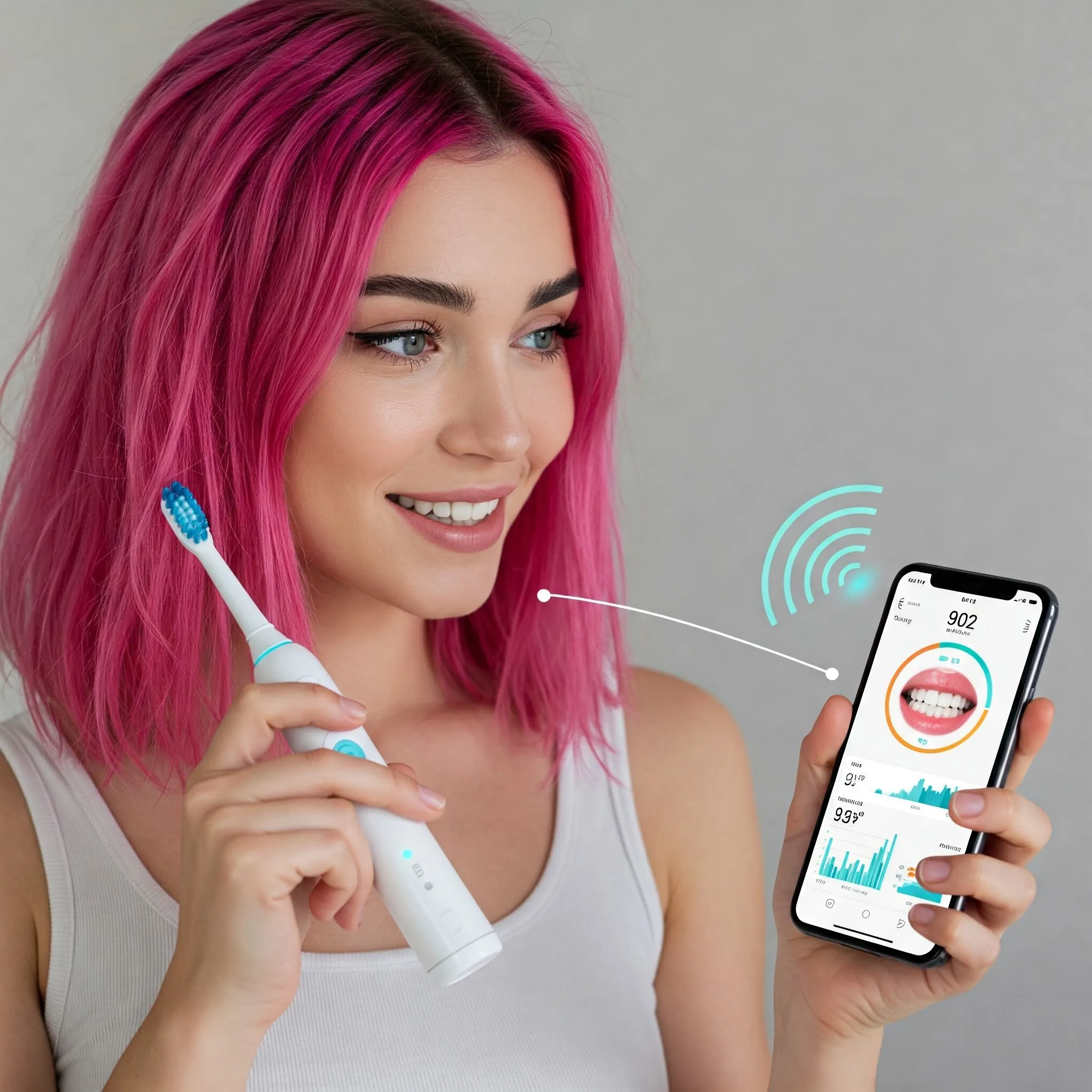
Using a smart electric toothbrush
Smart, app-connected electric toothbrushes have been on the market for a decade, promising to revolutionize oral hygiene through data tracking and personalized feedback. However, the reality often falls short of the hype, and these models typically come with a significantly higher price tag.
The Appeal of Smart Toothbrushes:
- Habit Tracking and Coaching: Smart toothbrushes connect to apps via Bluetooth to track brushing duration, frequency, and coverage. Some models even attempt to map brush head position within your mouth, offering feedback on areas you might be missing.
- Potential Benefits for Specific Users: Smart toothbrushes may be particularly beneficial for individuals who need extra guidance and motivation to improve their oral hygiene habits. This could include individuals with physical or neurological conditions that make brushing challenging, or those who benefit from gamification and visual feedback.
The Reality Check:
- Buggy Apps and Limited Value: Over the years, we've found that smart toothbrush apps can be buggy and the "smarter" the brush, the more prone to disappointment the experience. The app features may not always be accurate or consistently useful.
- High Cost: Smart toothbrushes are often double or even triple the price of standard electric toothbrushes.
- Data Privacy Concerns: Most app-connected toothbrushes collect personal data, and opting out of data sharing may require forgoing app use entirely.
====================================================================
Our Recommendation:
We recommend smart toothbrushes primarily for individuals who believe they would genuinely benefit from the added guidance and feedback offered by app connectivity. For most users, the core benefits of an electric toothbrush – the timer and powerful motor – are sufficient for effective cleaning. Many free apps are available for use with non-smart brushes to track brushing time and habits if desired.
Ultimately, while smart toothbrushes offer intriguing possibilities, they are not essential for achieving excellent oral hygiene. Focusing on brushing twice daily for two minutes with fluoride toothpaste and regular flossing remains the cornerstone of good oral health, regardless of whether you use a smart or non-smart toothbrush.
====================================================================
The Competition: Exploring Other Electric Toothbrush Brands and Models
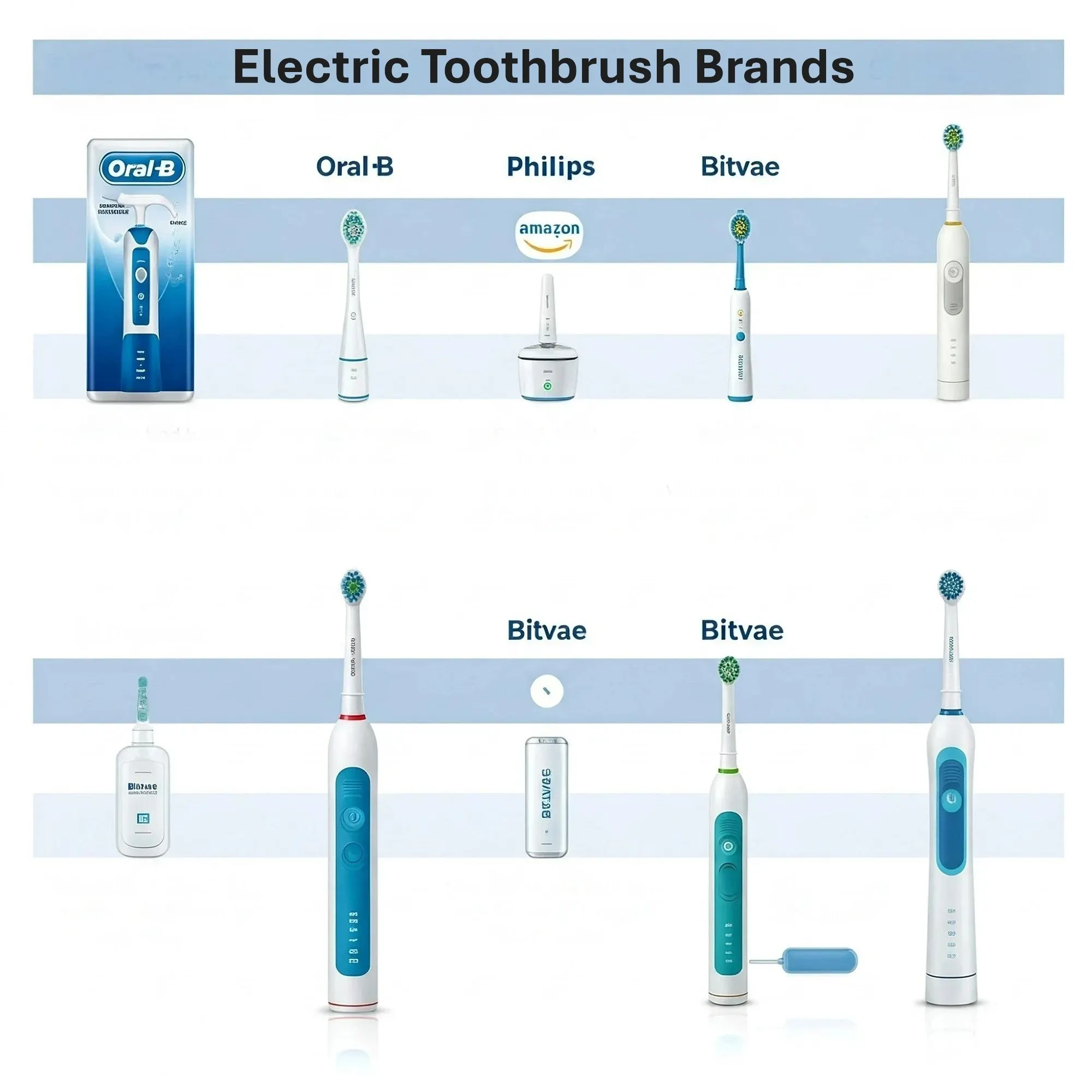
Other Electric Toothbrush Brands and Models
The electric toothbrush market is diverse, with numerous brands and models vying for your attention. Here’s a brief overview of some notable competitors and series beyond our top picks and alternatives:
Oscillating Toothbrushes:
- Oral-B Vitality ($20): Oral-B's most affordable rechargeable electric toothbrush. It's less powerful than our top picks and lacks quadrant pacing but includes a two-minute timer and compatibility with Oral-B brush heads.
- Oral-B iO Series (Starting at $50): Oral-B’s premium line of smart toothbrushes, featuring advanced technology, lighted pressure sensors, digital displays, app connectivity, and brush head position tracking (in higher-end models). They require specific, more expensive iO replacement brush heads.
- Oral-B Smart Series (Starting around $40): Mid-range models that offer features like pressure sensors and app connectivity (depending on the model). The Smart Series is being phased out in favor of the iO Series.
- Oral-B Genius Series (Starting around $80): Higher-end models with multiple cleaning modes, app connectivity, and brush head position tracking. Also being phased out for the iO Series.
- Amazon Basics Rechargeable Toothbrush (Currently Unavailable): A very budget-friendly option, but replacement brush heads are less readily available than Oral-B.
- Bitvae R2 ($25 with 2-year Refills): A very affordable option, often bundled with a large supply of replacement brush heads and featuring a pressure sensor and two-minute timer with quadrant pacing. However, it may be excessively noisy.
- Quip 360 ($55): Quip's rechargeable oscillating toothbrush, featuring quadrant pacing, a two-minute timer, pressure sensor, and multiple intensity settings. It has a somewhat unstable handle base and uses subscription-based refills.
====================================================================
Vibrating Toothbrushes:

Philips Sonicare series 2100, 3100, 5100, 5300, 6100, 6500, and 7500
Philips Sonicare Vibrating Toothbrush Series: A Model-by-Model Breakdown (2100 to 7500, Starting around $27): A broad range of models all utilizing the same sonic vibration technology as our recommended Sonicare 4100 and 1100. They vary in intensity levels, cleaning modes, and included accessories. Models like the 2100 and 3100 offer a more budget-friendly entry into the Sonicare line.
While the provided content doesn't give specific details for each individual model within the 2100-7500 series, we can understand that Philips Sonicare employs a tiered approach. Generally, as you ascend in model number, you gain more features and customization options. Think of it as "good, better, best" progressively up the line, catering to different budgets and needs.
Here's a likely breakdown of what you can expect as you move through the series:
Philips Sonicare 2100 ($27 estimated starting price): Entry-Level Sonic Power

Philips Sonicare 2100
The 2100 is your gateway into the Philips Sonicare experience. It delivers the fundamental sonic cleaning power that the brand is known for, often at the most accessible price point within the rechargeable range. Expect:
- Sonic Technology: The core 31,000 bristle movements per minute for effective plaque removal.
- Two Intensity Levels (Inferred): The text mentions the 2100 offers two intensity levels, suggesting you can adjust the brushing power to your comfort.
- One Cleaning Mode: Likely "Daily Clean," focusing on everyday oral hygiene.
- Two-Minute Timer and Quadrant Pacing: These essential features are standard across the Sonicare line, ensuring proper brushing duration and even coverage.
- Basic Handle Design: Expect a functional, but perhaps less feature-rich handle compared to higher models.
- Target Audience: Budget-conscious individuals looking to experience Sonicare technology without extra frills. First-time electric toothbrush users.
====================================================================
Philips Sonicare 3100: Stepping Up in Features
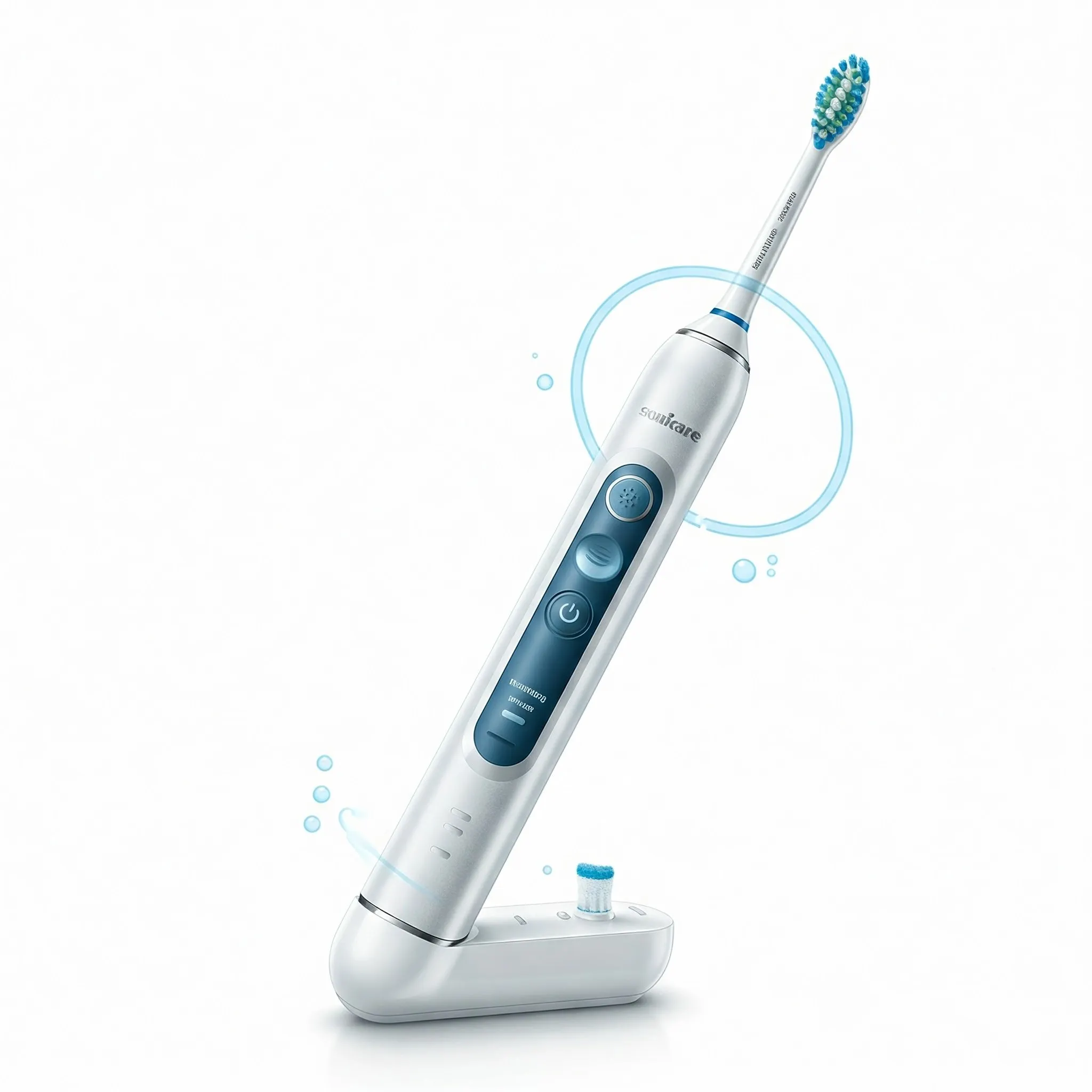
Philips Sonicare 3100
Moving slightly up to the 3100, you might gain some enhancements over the 2100. While specific details are scarce, we can anticipate:
- Sonic Technology (Same as 2100): Core cleaning power remains consistent.
- Potentially More Intensity Levels (Uncertain): It’s possible the 3100 might offer an additional intensity setting beyond the two in the 2100, but this is not explicitly stated in the text.
- One Cleaning Mode (Likely Daily Clean): Similar to the 2100, the focus is on essential cleaning.
- Two-Minute Timer and Quadrant Pacing: Standard features are maintained.
- Slightly Enhanced Handle or Design: Could have minor ergonomic improvements or a slightly more refined design compared to the 2100.
====================================================================
Philips Sonicare 5100 & 5300: Adding Cleaning Modes and Customization

Philips Sonicare 5100 & 5300
As we move into the 5000 series (represented by 5100 & 5300), expect to see a focus on increased customization and more specialized cleaning modes. These models likely aim to cater to users with specific oral health needs or preferences.
- Sonic Technology (Core Feature Maintained): The consistent 31,000 bristle movements remain the foundation of the cleaning power.
- Multiple Cleaning Modes (Expected): This is where the 5000 series is likely to differentiate itself. Expect to see modes beyond "Daily Clean," such as:
- Sensitive Mode: For gentle cleaning of sensitive teeth and gums.
- Whitening Mode: Potentially with a slightly different brushing pattern to aid in surface stain removal (often in conjunction with specialized brush heads).
- Intensity Levels (Likely Same or Increased): At least two intensity levels, potentially three, to further adjust the brushing experience.
- Two-Minute Timer and Quadrant Pacing (Standard): These continue to be essential features.
- Brush Head Replacement Reminder (Likely): A light or indicator to remind you to replace your brush head – already present in the 4100, so expected in higher models.
- Potentially Included Travel Case: As you move up in price, travel cases become a common inclusion.
- Target Audience: Users who want more than just basic cleaning and desire customized brushing modes for specific needs like sensitivity or whitening. Those who might travel frequently and appreciate a travel case.
====================================================================
Philips Sonicare 6100 & 6500: Premium Cleaning and Features
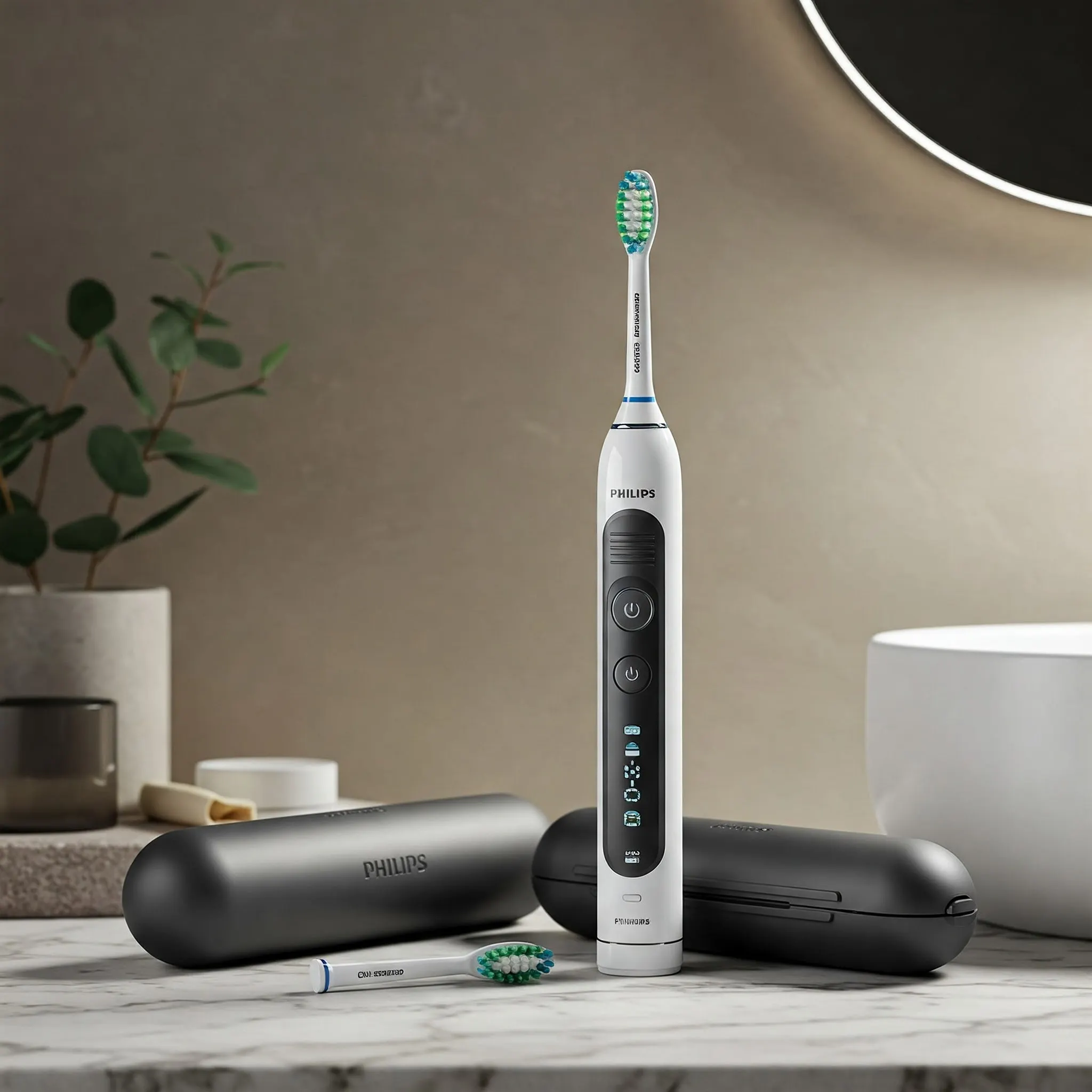
Philips Sonicare 6100
The 6000 series (6100 & 6500) likely represents a further step into the premium category within the Philips Sonicare vibrating toothbrush range. Here, you'd expect enhanced features, potentially improved performance (though the core sonic tech remains), and a more refined user experience.
- Sonic Technology (Consistent Core): The foundational cleaning power remains the same.
- Even More Cleaning Modes (Anticipated): Building upon the 5000 series, expect to see additional specialized cleaning modes such as:
- Gum Care Mode: Designed for gentle stimulation and cleaning along the gmline.
- Deep Clean Mode: Potentially for a longer or more intense cleaning cycle for thorough plaque removal.
- Possibly other specialized modes depending on the specific models and Philips' marketing at the time of release.
- Intensity Levels (Likely Three): Three intensity levels (low, medium, high) become increasingly common in higher-end models, offering granular control.
- Two-Minute Timer and Quadrant Pacing (Standard): Expected features are still present.
- Pressure Sensor (Likely): While not explicitly mentioned in the base text, a pressure sensor becomes increasingly probable at this price point for gum health protection.
- Brush Head Replacement Reminder (Likely): Standard feature in this range.
- Upgraded Handle Design and Materials: Expect a more ergonomic and premium-feeling handle, possibly with improved grip or materials.
- Included Travel Case (More Likely to be a Higher Quality Case): A travel case is almost certainly included, potentially a more robust or stylish version.
- Target Audience: Users who desire a premium brushing experience with multiple specialized cleaning modes and a more refined design. Those who value advanced features and are willing to invest more for a top-tier vibrating toothbrush.
====================================================================
Philips Sonicare 7500 ($200 estimated starting price): Top-of-the-Line Vibrating Power
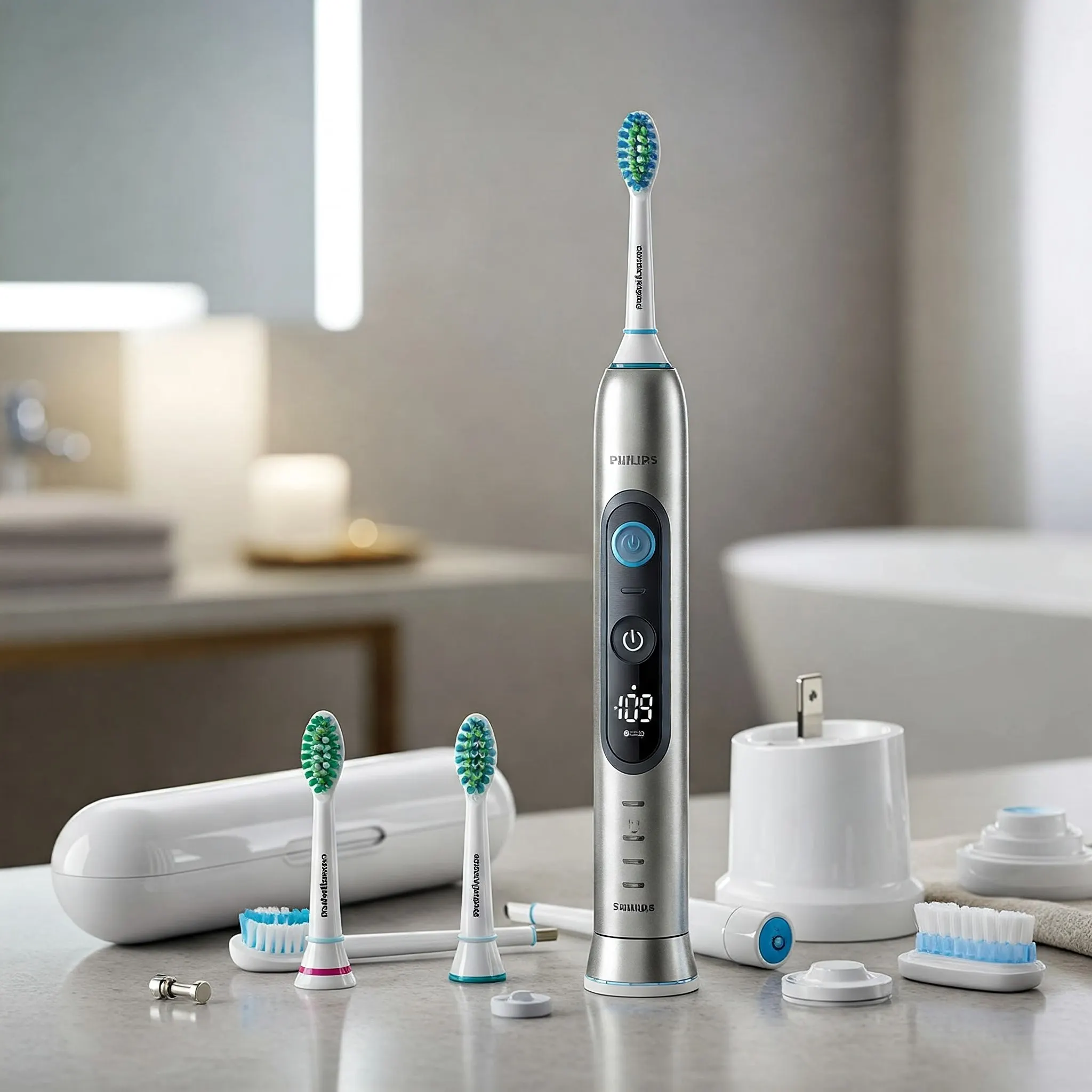
Philips Sonicare 7500
The 7500 likely sits at or near the top of the non-smart Philips Sonicare vibrating toothbrush lineup. It aims to provide the most comprehensive and luxurious brushing experience within the series, packed with features and accessories. At this price point, it starts to compete with lower-end smart toothbrushes in terms of cost.
- Sonic Technology (Core Technology Undchanged): The fundamental cleaning technology remains consistent throughout the series.
- Maximum Cleaning Modes (Most Expected): The 7500 should offer the widest array of cleaning modes within the series, potentially including all the modes mentioned previously (Daily Clean, Sensitive, Whitening, Gum Care, Deep Clean) and possibly more specialized options depending on the exact model specifications.
- Intensity Levels (Likely Three): Full intensity control.
- Two-Minute Timer and Quadrant Pacing (Standard): Core timing features are always present.
- Pressure Sensor (Highly Likely and Potentially Enhanced): Almost certain to include a pressure sensor, possibly with improved sensitivity or visual feedback compared to lower models (though not explicitly stated in the text).
- Brush Head Replacement Reminder (Standard): Expected feature.
- Premium Handle Design and Materials (Highest Quality): Likely features the most ergonomically advanced and premium-feeling handle in the series, potentially with higher-quality materials and a more sophisticated design.
- Comprehensive Accessory Package: Expect to find a full suite of accessories included, such as:
- High-quality travel case (potentially a charging travel case in some high-end electric toothbrushes, though not explicitly stated for this series).
- Multiple brush heads included (different types for various needs).
- Potentially a charging glass or other premium charging base (less likely in this specific series but possible depending on the exact model).
- Target Audience: Users who want the absolute best non-smart vibrating toothbrush experience Philips Sonicare offers. Those who desire every possible cleaning mode, a premium feel, and a full accessory package, and are willing to pay a higher price for these features. Potentially those who prefer a non-smart brush but still want a top-of-the-line model.
It's important to remember that these are inferred details based on common product tiering strategies and general knowledge of the Philips Sonicare line. For precise specifications of each model, always refer to the official product descriptions and manufacturer websites.
====================================================================
Final Thoughts: Choosing the Right Electric Toothbrush for You

Choosing between two electric toothbrushes
Ultimately, selecting the "best" electric toothbrush is a personal decision that hinges on your individual needs, preferences, and budget. Our extensive testing and expert consultation have consistently pointed to the Oral-B Pro 1000 as the top overall recommendation for its outstanding balance of cleaning power, essential features, durability, and affordability, especially when considering long-term replacement brush head costs. However, the Philips Sonicare 4100 stands out as a superb runner-up for those who prioritize a quieter brushing experience and appreciate the premium feel, even if it comes with slightly higher refill costs.
For those seeking budget-friendly options, the Oral-B Pro 500 and Philips Sonicare 1100 offer viable alternatives that retain the core benefits of electric brushing. And for those intrigued by advanced features, the Oral-B iO Series 6 presents a more interactive and high-tech experience, albeit at a premium price.
Smart toothbrushes, while innovative, remain a niche category. They may be beneficial for specific individuals who need extra guidance or motivation, but for most users, the core functionality of a good electric toothbrush, smart or not, is sufficient for maintaining excellent oral hygiene.
The key is to focus on the essential features – a powerful motor, a two-minute timer, and affordable replacement heads – and choose a model that aligns with your individual needs and preferences. Regardless of your choice, upgrading from a manual toothbrush to a quality electric toothbrush can be a worthwhile investment in your long-term oral health and a brighter, healthier smile.
====================================================================
Key Takeaways: Your Guide to Electric Toothbrush Success
- Prioritize Core Features: Focus on a powerful motor and a two-minute timer with quadrant pacing for effective cleaning.
- Consider Replacement Head Costs: Factor in the long-term expense of affordable and widely available replacement brush heads. This significantly impacts the overall cost of ownership.
- Oral-B Pro 1000: Top Pick for Value & Performance: Excellent cleaning, essential features, durable, and cost-effective refills.
- Philips Sonicare 4100: Runner-Up for Quieter Operation: Comparable cleaning, quieter, but pricier refills.
- Smart Toothbrushes: Not Essential for Most: Consider only if you specifically need app-based guidance and feedback, and be aware of potential buggy apps and data privacy.
- Manual vs. Electric: Electric Offers Advantages: Electric toothbrushes generally remove more plaque and improve brushing habits, but manual brushes are effective when used correctly.
- Personal Preference Matters: Ultimately, the best electric toothbrush is the one you find comfortable and effective to use consistently.
By keeping these key takeaways in mind, you'll be well-equipped to navigate the world of electric toothbrushes and choose the perfect model to elevate your oral hygiene routine.










